*NURSING > EXAM > Contemporary Maternal Newborn Nursing Care Maternal Newborn Nursing Care Nurse, Family, 8th Edition (All)
Contemporary Maternal Newborn Nursing Care Maternal Newborn Nursing Care Nurse, Family, 8th Edition By Patricia W. Ladewig Questions And Answers( Download To Score An A)
Document Content and Description Below
Ladewig, Contemporary Maternal-Newborn Nursing, 8/E Chapter 02 Question 1 Type: MCSA While conducting a family assessment, the nurse determines that a particular family’s structure is binucl... ear. Some potential challenges inherently faced by binuclear families include: Challenges related to co-parenting and joint custody, including negotiation and compromise between the parents about childrearing decisions. Issues related to both parents being employed, including child care, household chores, and spending time together. Challenges related to children interacting with peers and when revealing their parents’ sexual orientation. Issues related to single parenting, including lack of social and emotional support, need for assistance with childrearing, and financial strain. Correct Answer: 1 Rationale 1: Because both parents have equal responsibility and legal rights regarding their biologic child, binuclear families may inherently face challenges related to co-parenting and joint custody, including negotiation and compromise between the parents about childrearing decisions. Rationale 2: Issues inherently faced by the dual-career/dual-earner family include child care, household chores, and spending time together. Rationale 3: Children raised in gay and lesbian families may face challenges related to interacting with peers and when revealing their parents’ sexual orientation. Rationale 4: Binuclear families incorporate co-parenting, whereas with single parenting, one parent is responsible for child care. Issues inherently related to single parenting may include lack of social and emotional support, need for assistance with childrearing, and financial strain. Global Rationale: Cognitive Level: Analyzing Client Need: Health Promotion and Maintenance Client Need Sub: Nursing/Integrated Concepts: Nursing Process: Assessment Learning Outcome: LO01 – Describe how family type may influence nursing care of the childbearing family. Question 2 Type: MCSA The nurse is preparing a community presentation on family development. Which of the following statements should the nurse include? The youngest child’s age determines the family’s current stage. A family does not experience overlapping of stages. Family development ends when the youngest child leaves home. The stages describe the family’s progression over time. Correct Answer: 4 Rationale 1: The oldest child’s age is the marker for which stage the family is in, except for the two last stages, which occur after the children have left home. Rationale 2: Families with more than one child can experience multiple stages simultaneously. Rationale 3: Families with more than one child can experience multiple stages simultaneously. Rationale 4: Family development stages describe the changes and adaptations that a family goes through over time as children are added to the family. Global Rationale: Cognitive Level: Applying Client Need: Health Promotion and Maintenance Client Need Sub: Nursing/Integrated Concepts: Nursing Process: Assessment Learning Outcome: LO02 – Explain the changes that a childbearing family will undergo based on the developmental tasks to be completed. Question 3 Type: MCSA The nurse is preparing to assess the development of a family new to the clinic. The nurse understands that the primary use of a family assessment tool is to: Obtain a comprehensive medical history of family members. Determine which clinic the patient should be referred to. Predict how a family will likely change with the addition of children. Understand the physical, emotional, and spiritual needs of members. Correct Answer: 4 Rationale 1: The focus of a family assessment is the family as one entity. Health of the family is one area that is explored using a family assessment tool. Rationale 2: The family assessment tool facilitates understanding of the physical, emotional, and spiritual needs of members. Although referrals might take place as a result of the family assessment findings, understanding of the family is the primary reason the tool is used. Rationale 3: The family assessment tool facilitates understanding of the physical, emotional, and spiritual needs of members. Family development models help predict how a family will likely change with the addition of children. Rationale 4: This is the main reason for using a family assessment tool. Global Rationale: Cognitive Level: Applying Client Need: Health Promotion and Maintenance Client Need Sub: Nursing/Integrated Concepts: Nursing Process: Assessment Learning Outcome: LO03 – Identify information that would be useful to collect when performing a family assessment. Question 4 Type: MCSA The registered nurse is caring for a pregnant Muslim patient who is anticipating delivery within the next few days. The nurse asks if she and her husband have chosen a name for their baby. The patient quietly shakes her head, “no.” Based upon the patient’s response, the nurse understands that: The patient is not happily anticipating the arrival of her baby. Cultural beliefs may require the couple to choose the baby’s name following the birth. The patient does not speak English. Cultural beliefs may require that the baby’s name be kept secret until after the delivery. Correct Answer: 2 Rationale 1: There is no evidence to support that the patient is not happily anticipating her baby’s arrival. Rationale 2: In the Muslim culture, it is common to avoid naming the baby until after the baby is born. Rationale 3: The patient has been conversing with the nurse; no prior interaction suggested a language barrier. Rationale 4: Rather than keeping the baby’s name secret, in the Muslim culture, it is common to avoid naming the baby until the baby is born. Global Rationale: Cognitive Level: Analyzing Client Need: Health Promotion and Maintenance Client Need Sub: Nursing/Integrated Concepts: Nursing Process: Diagnosis Learning Outcome: LO04 – Integrate the prevalent cultural norms that affect childbearing and childrearing when providing care to that family. Question 5 Type: MCSA A woman of Korean descent has just given birth to a son. Her partner wishes to give her sips of hot broth from a thermos he brought from home. The patient has refused your offer of ice chips or other cold drinks. The nurse should: Explain to the patient that she can have the broth if she will also drink cold water or juice. Encourage the partner to feed the patient sips of broth. Ask if the patient would like you to bring her some warm water to drink as well. Explain to the couple that food can’t be brought from home but that the nurse will make hot broth for the patient. Encourage the patient to have the broth after the nurse takes it to the kitchen and boils it first. Correct Answer: Rationale 1: Explaining to the patient that she can have broth if she will drink cold water or juice first does not show cultural sensitivity and does not respect the patient’s beliefs. Rationale 2: Encouraging the partner to feed the patient sips of broth and asking if the patient would like you to bring her some warm water to drink as well is an approach that shows cultural sensitivity. The equilibrium model of health, based on the concept of balance between light and dark, heat and cold, is the foundation for this belief and practice. Rationale 3: Explaining to the couple that the hospital does not allow food brought from home but that you will make hot broth for them is an incorrect response. Rationale 4: Encouraging the patient to have broth after you take it the kitchen and boil it first is an incorrect response because boiling first would make the broth too hot to drink. Global Rationale: Cognitive Level: Applying Client Need: Health Promotion and Maintenance Client Need Sub: Nursing/Integrated Concepts: Nursing Process: Implementation Learning Outcome: LO04 – Integrate the prevalent cultural norms that affect childbearing and childrearing when providing care to that family. Question 6 Type: MCSA The nurse works in a facility that cares for patients from a broad range of racial, ethnic, cultural, and religious backgrounds. Which statement should the nurse include in a presentation for nurses new to the facility on the patient population of the facility? “Our patients come from a broad range of backgrounds, but we have a good interpreter service.” “Many of our patients come from backgrounds different from your own, but it doesn’t cause problems for the nurses.” “Because most of the doctors are bilingual, we don’t have to deal with the differences in cultural backgrounds of our patients.” “Understanding the common values and health practices of our diverse patients will facilitate better care and health outcomes.” Correct Answer: 4 Rationale 1: The role of a foreign language interpreter is to facilitate communication. The interpreter might or might not be able to interpret the cultural practices of patients. An example is a Spanish interpreter: The interpreter might be from Spain but interprets language for patients from Guatemala and Nicaragua, countries about which the interpreter might know virtually nothing. Rationale 2: Racial, ethnic, cultural, and religious backgrounds of patients have significant implications for how they perceive health, illness, and health care. It is important for nurses to understand the backgrounds of the patient population that attend that facility. Rationale 3: Bilingual physicians, like all physicians, have very busy schedules and often do not understand nursing care. It is the responsibility of the nurse to become familiar with the backgrounds of the patient population. Rationale 4: Because of the implications for care based on cultural background, it is important for nurses to understand the backgrounds of the patient population that attend the facility. Global Rationale: Cognitive Level: Analyzing Client Need: Health Promotion and Maintenance Client Need Sub: Nursing/Integrated Concepts: Nursing Process: Planning Learning Outcome: LO05 – Explain the importance of cultural competency in providing nursing care to the childbearing family. Question 7 Type: MCSA The nurse manager in a hospital with a large immigrant population is planning an in-service. The nurse manager is aware of how ethnocentrism affects nursing care. Which statement should the nurse manager include? “The belief that one’s own values and beliefs are the only or the best values: “Means that newcomers to the United States should adopt U.S. norms and values.” “Can create barriers to communication through misunderstanding.” “Leads to an expectation that patients will exhibit pain the same way.” “Improves the quality of care provided to culturally diverse patient bases.” Correct Answer: 2 Rationale 1: Although acculturation involves adoption of some of the majority culture’s practices and beliefs, each cultural group will continue to hold and express its own set of values and beliefs. Rationale 2: Ethnocentrism is the conviction that one’s own values and beliefs either are the only ones that exist or are the best. When the nurse assumes that a patient has the same values and beliefs as the nurse, misunderstanding will frequently occur, which in turn can negatively impact nurse–patient communication. Rationale 3: Expression of pain is one area that varies greatly from one culture to another. Rationale 4: The belief that one’s own values and beliefs are the best will not improve the quality of care provided to culturally diverse patient bases. Global Rationale: Cognitive Level: Applying Client Need: Psychosocial Integrity Client Need Sub: Nursing/Integrated Concepts: Nursing Process: Planning Learning Outcome: LO05 – Explain the importance of cultural competency in providing nursing care to the childbearing family. Question 8 Type: MCSA When preparing to teach a culturally diverse group of childbearing families about hospital birthing options, in order to be culturally competent, the nurse should: Understand that the families have the same values as the nurse. Teach the families how childbearing takes place in the United States. Insist that the clients answer questions instead of their husbands. Learn about the cultural groups that are likely to attend the class. Correct Answer: 4 Rationale 1: Assuming that the families have the same values is ethnocentrism. Rationale 2: Although it is important to explain health care during pregnancy and childbearing, this is not the top priority. Rationale 3: The husband’s answering questions might be a cultural norm, and insisting that the patient answer could decrease the family’s trust in the healthcare system. Rationale 4: Cultural competence is the development of skills and knowledge necessary to appreciate, understand, and work with individuals from other cultures than the culture of the nurse. Through gaining knowledge of the cultures that are likely to be encountered professionally, the nurse is able to understand the aspects of the patient’s culture that might impact how care should best be given to be accepted by the patient. Global Rationale: Cognitive Level: Applying Client Need: Health Promotion and Maintenance Client Need Sub: Nursing/Integrated Concepts: Nursing Process: Planning Learning Outcome: LO05 – Explain the importance of cultural competency in providing nursing care to the childbearing family. Question 9 Type: MCSA The nurse is admitting a Mexican woman scheduled for a cholecystectomy. The nurse uses a cultural assessment tool during the admission. Which question would be most important for the nurse to ask? “What other treatments have you used for your abdominal pain?” “What is your country of origin; where were you were born?” “When you talk to family members, how close do you stand?” “How would you describe your role within your family?” Correct Answer: 1 Rationale 1: This question is most important because some traditional or folk remedies include the use of herbs. Because some herbs have medication interactions, this physiologic question is imperative to ask. Rationale 2: Although this information is helpful, it is not a physiological issue. Asking about other treatments is a higher priority. Rationale 3: Although understanding the patient’s perception of appropriate personal space is helpful, it is not a physiological issue. Asking about other treatments is a higher priority. Rationale 4: Although understanding the patient’s family roles is helpful, it is not a physiological issue. Asking about other treatments is a higher priority. Global Rationale: Cognitive Level: Evaluating Client Need: Health Promotion and Maintenance Client Need Sub: Nursing/Integrated Concepts: Nursing Process: Planning Learning Outcome: LO06 – Interpret the information collected from a cultural assessment to provide culturally sensitive care. Question 10 Type: MCSA The labor and delivery nurse is caring for a laboring patient who has asked for a priest to visit her during labor. The patient’s mother died during childbirth, and although there are no complications during the patient’s pregnancy, she is fearful of her own death during labor. What is the best response of the nurse? “Nothing is going to happen to you. We’ll take very good care of you during your birth.” “Would you like to have an epidural so that you won’t feel the pain of the contractions?” “The priest won’t be able to prevent complications and might get in the way of your providers.” “Would you like me to contact your parish or our hospital chaplain to come see you?” Correct Answer: 4 Rationale 1: Avoid statements of false reassurance, as there are no guarantees in the outcomes during health care. Using these statements shuts down effective communication, as the patient’s concern is downplayed. Rationale 2: The patient’s expressed concern is not about pain; it is a fear of death and a desire to see a priest. Address the patient’s concerns directly. Rationale 3: Although this statement is true, it is not therapeutic. It downplays the patient’s concerns and will shut down effective communication. Address the concerns the patient expresses. Rationale 4: When the patient states she wants to see a priest, the nurse should attempt to make arrangements for this visit to occur in a timely manner. Most hospitals have a chaplaincy department that can provide assistance in obtaining the services of a wide variety of religious leaders. Depending on the day of the week and the time of day, the patient’s own home parish church might be able to provide a priest for pastoral care at the bedside. Global Rationale: Cognitive Level: Evaluating Client Need: Psychosocial Integrity Client Need Sub: Nursing/Integrated Concepts: Nursing Process: Planning Learning Outcome: LO07 – Identify ways a nurse might accommodate the religious rituals and practices of the childbearing family. Question 11 Type: MCSA A pregnant patient reports experiencing occasional gastroesophageal reflux. She explains that she relieves her symptoms through acupressure treatments, as well as by taking an over-the-counter medication recommended by her obstetrician. The nurse recognizes acupressure to be a form of: Homeopathy. Alternative therapy. Biofeedback. Complementary therapy. Correct Answer: 4 Rationale 1: Homeopathy entails using diluted amounts of substances that, if ingested in larger amounts, would produce effects similar to the symptoms of the disorder being treated. Rationale 2: Alternative therapy involves the use of a procedure or substance in place of conventional medicine. Rationale 3: Biofeedback control pertains to using the mind to control physiologic responses based on the concept that the mind controls the body. Rationale 4: Complementary therapy incorporates the use of a procedure or product as an adjunct to conventional medical treatment. Global Rationale: Cognitive Level: Analyzing Client Need: Physiological Integrity Client Need Sub: Nursing/Integrated Concepts: Nursing Process: Evaluation Learning Outcome: LO08 – Distinguish among complementary and alternative therapies. Question 12 Type: MCSA A patient reports using “homeopathic remedies” to ease her back pain. In order to more fully explore the patient’s use of complementary and alternative medicine (CAM), the nurse should ask: “Will you tell me more about the homeopathic remedies you’re using?” “Are you aware that some complementary and alternative therapies can be dangerous?” “Does your physician approve of your use of homeopathic remedies?” “Have you prioritized your need for comfort above your concern for your baby’s health?” Correct Answer: 1 Rationale 1: The nurse should ask direct, nonjudgmental questions when seeking to gain information about a patient’s use of CAM. Rationale 2: While tactful warnings regarding the use of CAM may be appropriate, the nurse should first explore the patient’s use of CAM in a nonjudgmental manner. Rationale 3: Patients may be reluctant to discuss their use of CAM with their healthcare providers; the nurse should explore the topic using nonjudgmental language. Rationale 4: Additional information is needed in order to evaluate the patient’s use of CAM, and the topic should be approached without use of disparaging comments. Global Rationale: Cognitive Level: Applying Client Need: Health Promotion and Maintenance Client Need Sub: Nursing/Integrated Concepts: Nursing Process: Planning Learning Outcome: LO08 – Distinguish between complementary and alternative therapies. Question 13 Type: MCSA The patient pregnant with her first child reports that her husband wants her to visit a homeopath for help with her nausea and vomiting. The patient asks what the nurse’s opinion of homeopathy is. The best response by the nurse is: “Homeopathy is unproven and potentially dangerous. Avoid using homeopathic remedies.” “The FDA has approved homeopathic remedies, and practitioners undergo education and certification.” “I can’t give you advice about what alternatives to try. Go online and do some research to get information.” “Homeopathy is the same as herbal remedies. Some are safe during pregnancy and some are not.” Correct Answer: 2 Rationale 1: Homeopathic remedies are not dangerous. Homeopathic remedies are FDA-approved and have been proven to be effective in treating a wide range of chronic and acute illnesses and conditions. Rationale 2: Homeopathic remedies are FDA-approved and have been proven to be effective in treating a wide range of chronic and acute illnesses and conditions. Rationale 3: It is appropriate for the nurse to provide factual information to educate a patient who has asked a question. Not all patients have access to computers, nor do they know how to do an internet search. Rationale 4: Herbalism and homeopathy are not the same. Herbs are available in many stores and preparations; some have been proven to be dangerous during pregnancy. Homeopathy is a system of “like curing like,” in which the symptom being treated would be a symptom of taking too much of the substance in a non-homeopathic form. Global Rationale: Cognitive Level: Evaluating Client Need: Health Promotion and Maintenance Client Need Sub: Nursing/Integrated Concepts: Nursing Process: Implementation Learning Outcome: LO09 – Describe the benefits and risks of the various complementary and alternative therapies to the childbearing family. Question 14 Type: MCMA Complementary and alternative therapies have many benefits for the childbearing family and others. However, many of these remedies have associated risks. Which of the following situations would be considered risks? Standard Text: Select all that apply. Getting a massage from a licensed massage therapist for back pain, prescribed by the primary caregiver Trying out a homeopathic medicine from a friend to reduce swelling in the legs Getting a chiropractic treatment for low back pain due to discomforts of pregnancy without telling the primary health care provider Taking an herbal preparation suggested by a health food store worker for treatment of leg pain Joining a group that practices tai chi weekly to help with physical fitness and movement Correct Answer: 2,3,4 Rationale 1: Getting a massage from a licensed massage therapist for back pain, prescribed by the primary caregiver, is a perfectly good use of complementary therapies. Rationale 2: Trying out a homeopathic medicine from a friend to reduce swelling in your legs is a risk factor when considering these therapies. Lack of standardization, lack of regulation and research to substantiate their safety and effectiveness, and inadequate training and certification of some healers make some therapies risky. Rationale 3: Getting a chiropractic treatment for low back pain due to discomforts of pregnancy without telling the primary health care provider is a risk factor when considering these therapies. Lack of standardization, lack of regulation and research to substantiate their safety and effectiveness, and inadequate training and certification of some healers make some therapies risky. Rationale 4: Taking an herbal preparation suggested by a health food store worker for treatment of leg pain is a risk factor when considering these therapies. Lack of standardization, lack of regulation and research to substantiate their safety and effectiveness, and inadequate training and certification of some healers make some therapies risky. Rationale 5: Joining a group that practices tai chi weekly to help with physical fitness and movement is a perfectly good use of complementary therapies. Global Rationale: Cognitive Level: Evaluating Client Need: Safe Effective Care Environment Client Need Sub: Management of Care Nursing/Integrated Concepts: Nursing Process: Evaluation Learning Outcome: LO09 – Describe the benefits and risks of the various complementary and alternative therapies to the childbearing family. Question 15 Type: MCSA The labor and delivery unit nurse manager is incorporating complementary and alternative therapies into the unit’s policies and procedures. Which statement should the nurse manager include during an in-service educational presentation for the nursing staff? “Policies have been developed for using massage and aromatherapy.” “When patients ask questions you don’t know, tell them to look online.” “Because herbs are dangerous during pregnancy, we will not use them.” “Be sure to ask patients what alternative therapies they have used.” Correct Answer: 1 Rationale 1: The development of written policies and procedures facilitates safe nursing practice, which in turn promotes patient safety. Rationale 2: Online information can vary in its accuracy. Reputable sources (electronic or print) should be recommended for further patient education. Rationale 3: This statement is false. Many herbs can be safely used during pregnancy. Rationale 4: What the patient has used in the past does not predict what she is open to using at present. It is more important to develop written policies and procedures. Global Rationale: Cognitive Level: Evaluating Client Need: Physiological Integrity Client Need Sub: Nursing/Integrated Concepts: Nursing Process: Planning Learning Outcome: LO10 – Formulate nursing care within the nurse practice act and with the informed consent of the patient when using appropriate complementary therapies with childbearing families. Ladewig, Contemporary Maternal-Newborn Nursing, 8/E Chapter 16 Question 1 Type: MCSA The nurse is supervising care in the emergency department. Which situation most requires an intervention? Moderate vaginal bleeding at 36 weeks’ gestation; patient has an IV of lactated Ringer’s solution running at 125 mL/hour Spotting of pinkish-brown discharge at 6 weeks’ gestation and abdominal cramping; ultrasound scheduled in one hour Bright red bleeding with clots at 32 weeks’ gestation; pulse = 110, blood pressure 90/50, respirations = 20 Dark red bleeding at 30 weeks’ gestation with normal vital signs; patient reports an absence of fetal movement Correct Answer: 3 Rationale 1: Bleeding in the third trimester is usually a placenta previa or placental abruption. Blood loss can be heavy and rapid, so having an IV stabilizes the patient’s vascular volume. Rationale 2: Bleeding in the first trimester can be indicative of spontaneous abortion beginning or of an ectopic pregnancy. An ultrasound will diagnose which situation is occurring and will determine care. Because this patient is very early in the pregnancy and only experiencing spotting, it is not appropriate to have an IV at this time. Rationale 3: Bleeding in the third trimester is usually a placenta previa or placental abruption. Blood loss can be heavy and rapid. This patient has a low blood pressure with an increased pulse rate, which indicates hypovolemic shock, which can be fatal to the mother and therefore the baby. Both lives are at risk in this situation. Since there is no information given that the patient has an IV started, this patient is the least stable, and therefore the highest priority. Rationale 4: Watery, dark red bleeding in the third trimester can indicate placental abruption with ruptured membranes. Normal vital signs indicate a normal vascular volume. A lack of fetal movement could indicate fetal hypoxia or fetal demise. The fetus is at greatest risk in this situation; the mother is stable. Global Rationale: Cognitive Level: Analyzing Client Need: Health Promotion and Maintenance Client Need Sub: Nursing/Integrated Concepts: Nursing Process: Assessment Learning Outcome: LO01 – Contrast the etiology, medical therapy, and nursing interventions for the various bleeding problems associated with pregnancy. Question 2 Type: MCSA The prenatal clinic nurse is caring for a patient with hyperemesis gravidarum at 14 weeks’ gestation. The vital signs are: blood pressure 95/48, pulse 114, respirations 24. Which order should the nurse implement first? Weigh the patient. Give 1 liter of lactated Ringer’s solution IV. Administer 30 ml Maalox (magnesium hydroxide) orally. Encourage clear liquids orally. Correct Answer: 2 Rationale 1: Weighing the patient provides information on weight gain or loss, but it is not the top priority in a patient with excessive vomiting during pregnancy. The vital signs indicate hypovolemia. The patient needs IV fluids. Rationale 2: The vital signs indicate hypovolemia. Giving this patient a liter of lactated Ringer’s solution intravenously will re-establish vascular volume and bring the blood pressure up, and the pulse and respiratory rate down. Rationale 3: The vital signs indicate hypovolemia. There is no indication that the patient has dyspepsia. The patient needs IV fluids. Rationale 4: The patient needs IV fluids because of the vital signs indicating hypovolemia. Oral fluids are not likely to be tolerated well by a patient with hyperemesis. Lack of tolerance of oral fluids through excessive vomiting is what has led to the hypovolemia. Global Rationale: Cognitive Level: Analyzing Client Need: Health Promotion and Maintenance Client Need Sub: Nursing/Integrated Concepts: Nursing Process: Planning Learning Outcome: LO02 – Discuss the medical therapy and nursing care for a woman with hyperemesis gravidarum. Question 3 Type: MCSA A 28-year-old woman who is at 16 weeks’ gestation has just undergone screening for ABO incompatibility. She asks the nurse why her blood contains anti-A antibodies. What is the nurse’s best response? “Anti-A antibodies occur naturally, as a result of exposure to foods and different infections.” “It’s most likely that you contracted anti-A antibodies through sexual activity.” “Anti-A antibodies are inherited; usually, they are genetically passed down from father to daughter.” “You may have contracted anti-A antibodies as a result of a viral infection.” Correct Answer: 1 Rationale 1: Anti-A and anti-B antibodies are naturally occurring; that is, women are naturally exposed to the A and B antigens through the foods they eat and through exposure to infection by gram negative bacteria. Rationale 2: Anti-A and anti-B antibodies are naturally occurring; that is, women are naturally exposed to the A and B antigens through the foods they eat and through exposure to infection by gram negative bacteria. Rationale 3: Women develop anti-A and anti-B antibodies naturally as a result of exposure to the A and B antigens through the foods they eat and through exposure to infection by gram negative bacteria. Rationale 4: Women develop anti-A and anti-B antibodies as a result of exposure to the A and B antigens through infection by gram negative bacteria, as well as through exposure to the foods they eat. Global Rationale: Cognitive Level: Understanding Client Need: Health Promotion and Maintenance Client Need Sub: Nursing/Integrated Concepts: Nursing Process: Planning Learning Outcome: LO06 – Compare Rh incompatibility to ABO incompatibility with regard to occurrence, clinical treatment, and implications for the fetus or newborn. Question 4 Type: MCSA While preparing a class on maternal-fetal ABO incompatibility for antepartum patients, the nurse is creating a brochure. Which statement should be included in the brochure information? In most cases, ABO incompatibility is limited to type A mothers with a type B or O fetus. Group A infants, because they have no antigenic sites on the red blood cells (RBCs), are never affected regardless of the mother’s blood type. In most cases, ABO incompatibility is limited to type O mothers with a type A or B fetus. ABO incompatibility occurs as a result of the fetal serum antibodies present and interaction between the antigen sites on the maternal RBCs. Correct Answer: 3 Rationale 1: In most cases, ABO incompatibility is limited to type O mothers with a type A or B fetus. The group B fetus of a group A mother and the group A fetus of a group B mother are only occasionally affected. Rationale 2: Group O infants, because they have no antigenic sites on the red blood cells (RBCs), are never affected regardless of the mother’s blood type. Rationale 3: In most cases, ABO incompatibility is limited to type O mothers with a type A or B fetus. The group B fetus of a group A mother and the group A fetus of a group B mother are only occasionally affected. Rationale 4: The incompatibility occurs as a result of the maternal antibodies present in her serum and interaction between the antigen sites on the fetal RBCs. Global Rationale: Cognitive Level: Analyzing Client Need: Health Promotion and Maintenance Client Need Sub: Nursing/Integrated Concepts: Nursing Process: Planning Learning Outcome: LO06 – Compare Rh incompatibility to ABO incompatibility with regard to occurrence, clinical treatment, and implications for the fetus or newborn. Question 5 Type: MCSA A patient who is at 32 weeks’ gestation is determined to be at high risk for ABO incompatibility. Which intervention should the nurse anticipate implementing? Intramuscular administration of 300 mcg of Rh immune globulin (RhoGAM) to the patient Notify the patient’s primary care provider and document the potential need for treatment of fetal hemolytic anemia in the patient’s baby after delivery. Obtain an antibody screen (indirect Coombs’ test) to determine whether the patient has developed isoimmunity. Note the potential for ABO incompatibility and plan to carefully assess the patient’s neonate for the development of hyperbilirubinemia. Correct Answer: 4 Rationale 1: RhoGAM is administered to prevent sensitization after exposure to Rh-positive blood. Rationale 2: Unlike Rh incompatibility, antepartum treatment of ABO incompatibility is not warranted because it does not cause severe anemia. Rationale 3: An antibody screen (indirect Coombs’ test) is done to determine whether an Rh-negative woman is sensitized (has developed isoimmunity) to the Rh antigen. Rationale 4: Unlike Rh incompatibility, antepartum treatment of ABO incompatibility is not warranted because it does not cause severe anemia. As part of the initial assessment, however, the nurse should note whether the potential for an ABO incompatibility exists in order to alert caregivers to the need for carefully assessing the newborn for the development of hyperbilirubinemia. Global Rationale: Cognitive Level: Applying Client Need: Health Promotion and Maintenance Client Need Sub: Nursing/Integrated Concepts: Nursing Process: Planning Learning Outcome: LO06 – Compare Rh incompatibility to ABO incompatibility with regard to occurrence, clinical treatment, and implications for the fetus or newborn. Question 6 Type: MCSA The nurse identifies the following assessment findings on a patient with pre-eclampsia: blood pressure 158/100; urinary output 50 mL/hour; lungs clear to auscultation; urine protein 11 on dipstick; and edema of the hands, ankles, and feet. On the next hourly assessment, which of the following new assessment findings would be an indication of worsening of the pre-eclampsia? Blood pressure 158/104 Urinary output 20 mL/hour Reflexes 21 Platelet count 150,000 Correct Answer: 2 Rationale 1: The blood pressure has not had a significant rise. Rationale 2: The decrease in urine output is an indication of decrease in GFR, which indicates a loss of renal perfusion. The assessment finding most abnormal and life-threatening is the urine output change. Rationale 3: The reflexes are normal at 21. Rationale 4: The platelet count is normal, though it is at the lower end. Global Rationale: Cognitive Level: Applying Client Need: Health Promotion and Maintenance Client Need Sub: Nursing/Integrated Concepts: Nursing Process: Assessment Learning Outcome: LO03 – Describe the development and course of hypertensive disorders associated with pregnancy. Question 7 Type: MCSA The community nurse is working with a patient at 32 weeks’ gestation who has been diagnosed with pre-eclampsia. Which statement indicates that additional information is needed? “I should call the doctor if I develop a headache or blurred vision.” “Lying on my left side as much as possible is good for the baby.” “My urine may become darker and smaller in amount each day.” “Pain in the top of my abdomen is a sign my condition is worsening.” Correct Answer: 3 Rationale 1: Headache and blurred vision or other visual disturbances are an indication of worsening pre-eclampsia and should be reported to the physician. Rationale 2: Left lateral position maximizes uterine and renal blood flow and therefore is the optimal position for a patient with pre-eclampsia. Rationale 3: Oliguria is a complication of pre-eclampsia caused by renal involvement and is a sign that the condition is worsening. Oliguria should be reported to the physician. Rationale 4: Epigastric pain is an indication of liver enlargement, a symptom of worsening pre-eclampsia, and should be reported to the physician. Global Rationale: Cognitive Level: Analyzing Client Need: Health Promotion and Maintenance Client Need Sub: Nursing/Integrated Concepts: Nursing Process: Evaluation Learning Outcome: LO04 – Describe the maternal and fetal/neonatal risks, clinical manifestations, and nursing care of the pregnant woman with a hypertensive disorder. Question 8 Type: MCSA The nurse is assessing a newly admitted patient who is 32 weeks’ gestation. The patient’s chief complaints are sudden onset of intense nausea and a frontal headache for the past two days. The patient’s initial blood pressure is 158/98 and she reports scant urination over the past 24 hours. Which intervention should the nurse anticipate implementing? Placing a wedge under the patient’s left hip so that she is in a right lateral tilt position Administration of diuretics and facilitating a dietary regimen of strict sodium restriction Conducting a urine dipstick test to assess for proteinuria Ordering a low-protein diet plan for the patient Correct Answer: 3 Rationale 1: This patient’s signs and symptoms are consistent with pre-eclampsia. Appropriate interventions include instituting bed rest with the patient positioned primarily on her left side, to decrease pressure on the vena cava, thereby increasing venous return, circulatory volume, and placental and renal perfusion. Rationale 2: This patient’s signs and symptoms are consistent with pre-eclampsia. Treatment includes avoidance of excessively salty foods, but sodium restriction and diuretics are no longer used in treating pre-eclampsia. Rationale 3: This patient’s signs and symptoms are consistent with pre-eclampsia. Treatment includes daily urine dipstick testing to assess for proteinuria. Rationale 4: This patient’s signs and symptoms are consistent with pre-eclampsia. Dietary interventions include moderate to high protein intake (80 to 100 g/day, or 1.5 g/kg/ day) to replace protein lost in the urine. Global Rationale: Cognitive Level: Analyzing Client Need: Physiological Integrity Client Need Sub: Nursing/Integrated Concepts: Nursing Process: Assessment Learning Outcome: LO03 – Describe the development and course of hypertensive disorders associated with pregnancy. Question 9 Type: MCSA The nurse receives the following report on a patient who delivered 36 hours ago: para 1, rubella immune, A-negative, antibody screen negative, newborn B-positive, Coombs’ negative, discharge orders are written for both mother and newborn. What should be the priority action by the nurse? Ask if she is breast- or bottle-feeding. Administer rubella vaccine. Determine if RhoGAM has been given. Discuss the discharge education with the patient. Correct Answer: 3 Rationale 1: This is important but is not the top priority. Rationale 2: The patient is rubella-immune and does not need the rubella vaccine. Rationale 3: The patient is A-negative and the newborn B-positive. The patient needs RhoGAM prior to discharge. Without RhoGAM, the patient will make antibodies against Rh-positive blood, and future pregnancies would be in jeopardy. Rationale 4: Discharge education is always important, but in this case it is not the most important action. Global Rationale: Cognitive Level: Analyzing Client Need: Health Promotion and Maintenance Client Need Sub: Nursing/Integrated Concepts: Nursing Process: Planning Learning Outcome: LO05 – Relate the cause, fetal/neonatal risks, prevention, and clinical therapy to the nursing care of the woman at risk for Rh alloimmunization. Question 10 Type: MCSA The patient with blood type A, Rh-negative delivered yesterday. Her infant is blood type AB, Rh-positive. Which statement indicates that teaching has been effective? “I need to get RhoGAM so I don’t have problems with my next pregnancy.” “Because my baby is Rh-positive, I don’t need RhoGAM.” “If my baby had the same blood type I do, it might cause complications.” “Before my next pregnancy, I will need to have a RhoGAM shot.” Correct Answer: 1 Rationale 1: Rh-negative mothers who give birth to Rh-positive infants should receive Rh immune globulin (RhoGAM) to prevent alloimmunization, which could cause fetal anemia and other complications during the next pregnancy. Rationale 2: Rh-negative mothers who give birth to Rh-positive infants should receive Rh immune globulin (RhoGAM) to prevent alloimmunization. Rationale 3: It is specifically the Rh factor that causes complications; ABO grouping does not cause alloimmunization. Rationale 4: Rh-negative mothers who give birth to Rh-positive infants should receive Rh immune globulin (RhoGAM). The injection must be given with 72 hours after delivery to prevent alloimmunization. Global Rationale: Cognitive Level: Applying Client Need: Health Promotion and Maintenance Client Need Sub: Nursing/Integrated Concepts: Nursing Process: Evaluation Learning Outcome: LO05 – Relate the cause, fetal/neonatal risks, prevention, and clinical therapy to the nursing care of the woman at risk for Rh alloimmunization. Question 11 Type: MCSA Which maternal–child patient should the nurse see first? Blood type O, Rh-negative Indirect Coombs’ test negative Direct Coombs’ test positive Blood type B, Rh-positive Correct Answer: 3 Rationale 1: This patient is Rh-negative, but there is no indication that the alloimmunization has occurred. Rationale 2: An indirect Coombs’ test looks for Rh antibodies in the maternal serum; a negative result indicates the patient has not been alloimmunized. Rationale 3: A direct Coombs’ test looks for Rh antibodies in the fetal blood circulation. A positive result indicates that that there is an Rh incompatibility between mother and infant, and the baby is making anti-Rh antibodies, which in turn leads to hemolysis. This infant is at risk for anemia and hyperbilirubinemia. Rationale 4: This patient’s blood type creates no problems. Global Rationale: Cognitive Level: Applying Client Need: Health Promotion and Maintenance Client Need Sub: Nursing/Integrated Concepts: Nursing Process: Assessment Learning Outcome: LO05 – Relate the cause, fetal/neonatal risks, prevention, and clinical therapy to the nursing care of the woman at risk for Rh alloimmunization. Question 12 Type: MCSA Which situation in the high-risk antepartal unit requires immediate intervention? A third-trimester patient pregnant with twins who required an appendectomy yesterday is positioned in a supine position. Oxygen is being administered at 2 L via nasal cannula to a patient in her third trimester who underwent an urolithotomy today. Fetal monitoring is being performed on a patient in her third trimester who is scheduled for a cholecystectomy tomorrow. The patient in her third trimester who returned from bowel resection surgery has a nasogastric tube attached to intermittent suction. Correct Answer: 1 Rationale 1: A patient undergoing surgery in the third trimester should be positioned in a left lateral position or with a hip wedge placed. Being supine will cause vena cava syndrome and hypotension, which in turn will decrease fetal oxygenation. Twin gestation, with the larger uterus and heavier uterine contents, makes vena cava syndrome more problematic. Rationale 2: Oxygen is required during and after surgery during pregnancy to maintain adequate fetal oxygenation. Rationale 3: Fetal monitoring prior to, during, and after surgery on pregnant patients is important to assess the fetal condition. Rationale 4: Due to the decreased peristalsis of pregnancy, pregnant patients who undergo abdominal surgery are at risk for vomiting. An NG tube is placed to prevent vomiting. Global Rationale: Cognitive Level: Analyzing Client Need: Health Promotion and Maintenance Client Need Sub: Nursing/Integrated Concepts: Nursing Process: Planning Learning Outcome: LO07 – Summarize the risks and implications of surgical procedures performed during pregnancy. Question 13 Type: MCSA The nurse is caring for a patient at 35 weeks’ gestation who has been critically injured in a shooting. Which statement by the paramedics bringing the woman to the hospital would cause the greatest concern? “Blood pressure 110/68, pulse 90.” “Entrance wound present below the umbilicus.” “Patient is positioned in a left lateral tilt.” “Clear fluid is leaking from the vagina.” Correct Answer: 2 Rationale 1: These are normal vital signs, indicating a hemodynamically stable patient. Rationale 2: Penetrating abdominal trauma has a 59–80% fetal injury rate. This fetus is at great risk for injury. Rationale 3: Positioning the patient in a lateral tilt position prevents vena cava syndrome. Rationale 4: Clear fluid from the vagina could be amniotic fluid from spontaneous rupture of the membranes. Although this is not a normal finding at 35 weeks, this fetus is near term and would likely survive birth at this time. Global Rationale: Cognitive Level: Applying Client Need: Health Promotion and Maintenance Client Need Sub: Nursing/Integrated Concepts: Nursing Process: Assessment Learning Outcome: LO08 – Discuss the implications of trauma caused by an accident or battering for the pregnant woman and her fetus. Question 14 Type: MCSA The nurse is admitting a patient at 28 weeks’ gestation to the emergency department following an episode of domestic abuse resulting in ecchymosis and lacerations. Which question is most critical to ask? “What did you do to make your spouse so angry?” “How many times has this happened in the past?” “Do you have a safe place that you can go?” “Will you be pressing charges against your spouse?” Correct Answer: 3 Rationale 1: This statement is blaming and must be avoided to establish a trusting, therapeutic relationship with an abused patient. Rationale 2: Although domestic abuse tends to increase in frequency and violence during pregnancy, this is not the highest priority. Rationale 3: This question is the highest priority because having a safe place to go after leaving the hospital reduces the risk of a repeated attack and further injury to both mother and fetus. Rationale 4: Legal issues are a low priority at this time. Physiologic issues such as safety in the future have more importance. Global Rationale: Cognitive Level: Applying Client Need: Health Promotion and Maintenance Client Need Sub: Nursing/Integrated Concepts: Nursing Process: Planning Learning Outcome: LO08 – Discuss the implications of trauma caused by an accident or battering for the pregnant woman and her fetus. Question 15 Type: MCSA Which statement indicates that teaching has been effective? “Because I have toxoplasmosis, my baby might be born with an abnormally long body.” “The rubella infection I experienced in my second trimester may lead me to become deaf.” “My baby may develop a serious blood infection because I have group B strep in my vagina.” “My 8-year-old’s parvovirus infection won’t affect my baby because I am four months along.” Correct Answer: 3 Rationale 1: Toxoplasmosis during pregnancy can cause fetal microcephaly, hydrocephalus, coma, convulsions, or retinochoroiditis. Rationale 2: Rubella infection during pregnancy can lead to fetal deafness, congenital heart defects, and developmental delays in the fetus. Maternal deafness is not a risk for perinatal rubella. Rationale 3: Group B streptococcus can cause neonatal septicemia or pneumonia unless IV antibiotics are given during labor. Rationale 4: Parvovirus effects on the fetus are most severe when the maternal infection occurs prior to the 20th week. Global Rationale: Cognitive Level: Applying Client Need: Health Promotion and Maintenance Client Need Sub: Nursing/Integrated Concepts: Nursing Process: Evaluation Learning Outcome: LO09 – Contrast the effects of various infections on the pregnant woman and her unborn child. Ladewig, Contemporary Maternal-Newborn Nursing, 8/E Chapter 32 Question 1 Type: MCMA The nurse is preparing a community education class on healthy pregnancy. Which statements should be included? Standard Text: Select all that apply. Eating a well-balanced diet helps prevent pregnancy complications. Stress management and support systems are important in pregnancy. Prenatal care can be obtained at any point in the pregnancy. Complications during a prior pregnancy do not recur. Exercising regularly facilitates feeling better in pregnancy. Correct Answer: 1,2,5 Rationale 1: Good overall nutrition helps reduce the incidence of many pregnancy complications, including anemia, preterm labor, and delivery complications such as shoulder dystocia. Rationale 2: Patients with high stress levels and poor support systems are more likely to develop postpartum depression and have problems parenting. Rationale 3: Early and regular prenatal care is important to provide education that can help prevent complications, and to detect complications as they develop. Rationale 4: Many complications of pregnancy have a tendency to recur, including postpartum hemorrhage, postpartum depression, preterm labor, and premature rupture of membranes. Rationale 5: Regular exercise during pregnancy helps prevent hypertension and gestational diabetes, helps reduce length of labor, and helps patients feel good. Global Rationale: Cognitive Level: Applying Client Need: Health Promotion and Maintenance Client Need Sub: Nursing/Integrated Concepts: Nursing Process: Planning Learning Outcome: LO01: Identify the nurse’s impact in both the hospital and community-based settings in assessing predisposing factors of postpartum complications, implementing preventive care, and teaching for self-help. Question 2 Type: MCSA A patient is 3 days postop from a cesarean birth. She has tenderness, localized heat, and redness of the left leg. She is afebrile. As a result of these symptoms, she most likely will be: Encouraged to ambulate freely. Given aspirin 650 mg by mouth. Given Methergine IM. Placed on bed rest. Correct Answer: 4 Rationale 1: That would increase the inflammation. Rationale 2: Aspirin 650 mg by mouth has anticoagulant properties, but usually is not necessary unless complications occur. Rationale 3: Methergine is given only for postpartum hemorrhage, and would only cause vasoconstriction of an already inflamed vessel. Rationale 4: These symptoms indicate the presence of superficial thrombophlebitis. The treatment involves bed rest and elevation of the affected limb, analgesics, and use of elastic support hose. Global Rationale: Cognitive Level: Applying Client Need: Health Promotion and Maintenance Client Need Sub: Nursing/Integrated Concepts: Nursing Process: Diagnosis Learning Outcome: LO01: Identify the nurse’s impact in both the hospital and community-based settings in assessing predisposing factors of postpartum complications, implementing preventive care, and teaching for self-help. Question 3 Type: MCSA The nurse is assisting a multiparous woman to the bathroom for the first time since her delivery 3 hours ago. When the patient stands up, blood runs down her legs and pools on the floor. The patient turns pale and feels weak. The first action of the nurse is to: Assist the patient to empty her bladder. Help the patient back to bed to check her fundus. Assess her blood pressure and pulse. Begin an IV of Lactated Ringer’s infusion. Correct Answer: 2 Rationale 1: The patient might be experiencing a postpartum hemorrhage. Her fundus is not contracting well. Although this might be due to a full bladder, the best first step is to massage the fundus. Rationale 2: Massaging the fundus is the top priority because of the excessive blood loss. If the fundus is boggy, fundal massage may stimulate toning of the uterus and prevent further blood loss. Rationale 3: Massaging the fundus is the top priority because of the excessive blood loss. Blood pressure and pulse do not change until 1000–2000 ml of blood has been lost. Massaging the fundus will prevent further blood loss. Rationale 4: Massaging the fundus is the top priority because of the excessive blood loss. An IV might need to be started if the patient becomes symptomatic. Global Rationale: Cognitive Level: Applying Client Need: Health Promotion and Maintenance Client Need Sub: Nursing/Integrated Concepts: Nursing Process: Implementation Learning Outcome: LO02: Explain the causes, contributing factors, signs and symptoms, clinical therapy, and nursing interventions for early and late postpartum hemorrhage. Question 4 Type: MCMA A patient is experiencing excessive bleeding immediately after the birth of her newborn. After speeding up the IV fluids containing oxytocin, with no noticeable decrease in the bleeding, the nurse should anticipate the physician requesting which medications? Standard Text: Select all that apply. Methergine Stadol Misoprostol Betamethasone Correct Answer: 1,3 Rationale 1: Methergine is a drug of choice for postpartum hemorrhage. Rationale 2: Stadol is an analgesic, and is not used for postpartum hemorrhage. Rationale 3: Misoprostol is commonly administered rectally for postpartum hemorrhage. Rationale 4: Betamethasone is a glucocorticoid used for preterm labor in an attempt to decrease respiratory distress in the preterm infant. Global Rationale: Cognitive Level: Applying Client Need: Health Promotion and Maintenance Client Need Sub: Nursing/Integrated Concepts: Nursing Process: Implementation Learning Outcome: LO02: Explain the causes, contributing factors, signs and symptoms, clinical therapy, and nursing interventions for early and late postpartum hemorrhage. Question 5 Type: MCSA The postpartum patient who delivered 2 days ago has developed endometritis. Which charting entry would the nurse expect to find in this patient’s chart? “Cesarean birth performed secondary to arrest of dilation.” “Rupture of membranes occurred 2 hours prior to delivery.” “External fetal monitoring used throughout labor.” “Patient has history of pregnancy-induced hypertension.” Correct Answer: 1 Rationale 1: Cesarean birth is the greatest predictor of postpartum endometritis. The frequent cervical exams necessary to assess for arrest of dilation are another risk factor for postpartum infection. Rationale 2: Prolonged rupture of membranes (longer than 12 hours) is a risk factor for postpartum endometritis. Rationale 3: Internal fetal monitoring (both internal fetal scalp electrode and intrauterine pressure catheter) are risk factors for postpartum endometritis. Rationale 4: Pregnancy-induced hypertension is not a risk factor for development of postpartum endometritis. Global Rationale: Cognitive Level: Applying Client Need: Health Promotion and Maintenance Client Need Sub: Nursing/Integrated Concepts: Nursing Process: Assessment Learning Outcome: LO03: Develop a nursing care plan that reflects the etiology, pathophysiology, current clinical therapy, nursing management, and preventive management for the woman with reproductive tract infection, urinary tract infection, lactation mastitis, thromboembolic disease, or a postpartum psychiatric disorder. Question 6 Type: MCSA The patient at 3 days postpartum has come to the maternity clinic with complaints of urinary urgency and dysuria. Which statement is most important for the nurse to make? “Void into this sterile cup without touching the inside of the cup.” “Be sure to wipe from back to front after you have a bowel movement.” “Call the clinic if you develop nausea and vomiting or constipation.” “Decrease your fluid intake for a few days, but eat a lot of vegetables.” Correct Answer: 1 Rationale 1: A clean-catch urine sample will need to be obtained for urinalysis to determine if the patient has developed a urinary tract infection. Rationale 2: Patients should be taught to wipe from front to back after bowel movements in order to prevent contamination of the urethra and bladder with normal bowel flora. Rationale 3: A lower urinary tract infection can progress into pyelonephritis, the signs of which are fever and flank pain. Constipation is not associated with urinary tract infections. Rationale 4: Patients should increase their fluid intake but decrease their consumption of carbonated beverages. Cranberries, or cranberry juice, are helpful, as they acidify the urine. Vegetables do not help clear or prevent urinary tract infections. Global Rationale: Cognitive Level: Applying Client Need: Health Promotion and Maintenance Client Need Sub: Nursing/Integrated Concepts: Nursing Process: Implementation Learning Outcome: LO03: Develop a nursing care plan that reflects the etiology, pathophysiology, current clinical therapy, nursing management, and preventive management for the woman with reproductive tract infection, urinary tract infection, lactation mastitis, thromboembolic disease, or a postpartum psychiatric disorder. Question 7 Type: MCSA Which method of initial assessment would best indicate whether a patient has a urinary complication? Urine pH Calculation of urine output Urine-specific gravity Calculation of intake Correct Answer: 2 Rationale 1: Urine pH and urine-specific gravity can be used to identify certain conditions, but would not be part of the initial assessment. Rationale 2: Calculation of output would provide a better assessment of complete emptying of the bladder, because overdistention can cause trauma to the bladder, displace the uterus, and cause infection. Rationale 3: Urine pH and urine-specific gravity can be used to identify certain conditions, but would not be part of the initial assessment. Rationale 4: Monitoring intake is an intervention that may help prevent urinary complications but calculating the intake itself would not indicate a complication. Global Rationale: Cognitive Level: Applying Client Need: Physiological Integrity Client Need Sub: Nursing/Integrated Concepts: Nursing Process: Assessment Learning Outcome: LO03: Develop a nursing care plan that reflects the etiology, pathophysiology, current clinical therapy, nursing management, and preventive management for the woman with reproductive tract infection, urinary tract infection, lactation mastitis, thromboembolic disease, or a postpartum psychiatric disorder. Question 8 Type: MCSA The postpartum multipara is breastfeeding her new baby. The patient states that she developed mastitis with her first child, and asks if there is something she can do to prevent mastitis this time. The best response of the nurse is: “Massage your breasts on a daily basis, and if you find a hardened area, massage it towards the nipple to unblock that duct.” “Most first-time moms experience mastitis. It is really quite unusual for a woman having her second baby to get it again.” “Apply cold packs to any areas that feel thickened or firm in order to relieve the swelling and stasis of the milk in that area.” “Take your temperature once a day. This will help you to pick up the infection early, before it becomes severe.” Correct Answer: 1 Rationale 1: A hardened area could indicate a blocked duct. Massage of the blocked duct toward the nipple will help to unplug the duct and relieve stasis of the milk, thereby preventing mastitis. Rationale 2: It is not unusual for mothers to develop complications similar to those experienced in prior pregnancies. Rationale 3: Warm packs, not cold packs, should be applied to areas that are warm, red, or hardened. Rationale 4: The onset of mastitis is quite rapid, and taking the temperature daily is not likely to be helpful for catching early onset of the infection. Massaging the area to unplug the duct and relieve milk stasis is much more effective. Global Rationale: Cognitive Level: Applying Client Need: Health Promotion and Maintenance Client Need Sub: Nursing/Integrated Concepts: Nursing Process: Implementation Learning Outcome: LO03: Develop a nursing care plan that reflects the etiology, pathophysiology, current clinical therapy, nursing management, and preventive management for the woman with reproductive tract infection, urinary tract infection, lactation mastitis, thromboembolic disease, or a postpartum psychiatric disorder. Question 9 Type: MCMA A nurse suspects that a postpartum patient has mastitis. The following assessment provides what data to support this assessment? Standard Text: Select all that apply. Shooting pain in her nipple during breastfeeding. Late onset of nipple pain Pink, flaking, pruritic skin of the affected nipple. Nipple soreness when the infant latches on. Correct Answer: 1,2,3 Rationale 1: Mastitis is characterized by late-onset nipple pain, followed by shooting pain during and between feedings. Rationale 2: Mastitis is characterized by late-onset nipple pain, followed by shooting pain during and between feedings. Rationale 3: The skin of the affected breast becomes pink, flaking, and pruritic. Rationale 4: Nipple soreness, engorgement, and the letdown reflex do not share these symptoms. Global Rationale: Cognitive Level: Applying Client Need: Health Promotion and Maintenance Client Need Sub: Nursing/Integrated Concepts: Nursing Process: Assessment Learning Outcome: LO03: Develop a nursing care plan that reflects the etiology, pathophysiology, current clinical therapy, nursing management, and preventive management for the woman with reproductive tract infection, urinary tract infection, lactation mastitis, thromboembolic disease, or a postpartum psychiatric disorder. Question 10 Type: MCSA The postpartum patient has developed thrombophlebitis in her right leg. Which finding requires immediate intervention? The patient: The postpartum patient has developed thrombophlebitis in her right leg. Which finding requires immediate intervention? The patient: Develops pain and swelling in her left lower leg. Appears anxious, and describes pressure in her chest. Becomes upset that she can’t go home yet. Correct Answer: 3 Rationale 1: This is a risk factor for the development of thrombophlebitis, but neither a predictor nor an indication of complications. Rationale 2: Development of bilateral thrombophlebitis is a complication, but not the top priority. Rationale 3: Anxiety and sudden onset of chest pain or pressure might indicate pulmonary embolus, which is a life-threatening complication of thrombophlebitis. This is the most abnormal finding, and requires immediate intervention. Rationale 4: Although the nurse provides patient care with the aim of keeping patients satisfied and comfortable, becoming upset is a psychosocial issue, and far less important than development of a pulmonary embolus. Global Rationale: Cognitive Level: Analyzing Client Need: Physiological Integrity Client Need Sub: Nursing/Integrated Concepts: Nursing Process: Assessment Learning Outcome: LO03: Develop a nursing care plan that reflects the etiology, pathophysiology, current clinical therapy, nursing management, and preventive management for the woman with reproductive tract infection, urinary tract infection, lactation mastitis, thromboembolic disease, or a postpartum psychiatric disorder. Question 11 Type: MCSA The nurse is revising the care plan of a 26-year-old woman who has developed mastitis. Which nursing diagnosis is most appropriate for inclusion in this patient’s updated plan of care? Ineffective Peripheral Tissue Perfusion related to obstructed venous return Risk for Trauma related to lack of information about appropriate breastfeeding practices. Deficient Knowledge related to self-care after discharge on anticoagulant therapy Acute Pain related to tissue hypoxia and edema secondary to vascular obstruction Correct Answer: 2 Rationale 1: In relation to the patient’s mastitis, the most appropriate nursing diagnosis is Risk for Trauma related to lack of information about appropriate breastfeeding practices. Rationale 2: In relation to the patient’s mastitis, the most appropriate nursing diagnosis is Risk for Trauma related to lack of information about appropriate breastfeeding practices. Rationale 3: In relation to the patient’s mastitis, the most appropriate nursing diagnosis is Risk for Trauma related to lack of information about appropriate breastfeeding practices. Rationale 4: In relation to the patient’s mastitis, the most appropriate nursing diagnosis is Risk for Trauma related to lack of information about appropriate breastfeeding practices. Global Rationale: Cognitive Level: Evaluating Client Need: Physiological Integrity Client Need Sub: Nursing/Integrated Concepts: Nursing Process: Diagnosis Learning Outcome: LO 03: Develop a nursing care plan that reflects the etiology, pathophysiology, current clinical therapy, nursing management, and preventive management for the woman with reproductive tract infection, urinary tract infection, lactation mastitis, thromboembolic disease, or a postpartum psychiatric disorder. Question 12 Type: MCSA The nurse is calling postpartum patients. Which patient should be seen immediately? The patient at 4 weeks postpartum who: Describes feeling sad all the time. Reports hearing voices talking about the baby. States she has no appetite and wants to sleep all day. Says she needs a refill on her sertraline (Zoloft) next week. Correct Answer: 2 Rationale 1: While this may indicate postpartum blues or postpartum depression, and is not the highest priority. Rationale 2: This is an indication the patient is experiencing postpartum psychosis, and is the highest priority, because the voices might tell her to harm her baby. Rationale 3: This is an indication the patient is experiencing may be experiencing postpartum depression, but is not the highest priority. Rationale 4: A patient on medications needs refills on time, but right now she has medication, and therefore is not a high priority. Global Rationale: Cognitive Level: Evaluating Client Need: Physiological Integrity Client Need Sub: Nursing/Integrated Concepts: Nursing Process: Assessment Learning Outcome: LO03: Develop a nursing care plan that reflects the etiology, pathophysiology, current clinical therapy, nursing management, and preventive management for the woman with reproductive tract infection, urinary tract infection, lactation mastitis, thromboembolic disease, or a postpartum psychiatric disorder. Question 13 Type: MCSA The maternal nurse educator is conducting a presentation for antepartum patients describing the identification and care of women diagnosed with postpartum psychiatric disorders. Which information should the maternal nurse educator include in her teaching content? Postpartum depression occurs in as many as 50% to 70% of mothers and is characterized by mild depression interspersed with happier feelings. Postpartum depression is typically mild and usually self-limiting, lasting up to 6 weeks. Even if she is asymptomatic, a woman with a history of postpartum depression should be referred to a mental health professional for counseling and biweekly visits postpartum. Women with postpartum depression have a history of exposure to an extremely traumatic personal event that involves actual or threatened death or serious injury and evokes intense fear, helplessness, or horror. Correct Answer: 3 Rationale 1: As many as 50% to 70% of mothers develop adjustment reaction with depressed mood, which is also known as postpartum blues, or as maternal or baby blues. Unlike postpartum depression, this condition is characterized by mild depression interspersed with happier feelings. Rationale 2: Postpartum blues typically manifest as mild symptoms that are transient and self-limiting. Postpartum depression is severe and poses major threats to the woman and the infant, as well as to the father/partner. Rationale 3: Women with a history of postpartum psychosis or depression or other risk factors should be referred to a mental health professional for counseling and biweekly visits between the second and sixth week postpartum for evaluation. Rationale 4: Post-traumatic stress disorder or PTSD (also called post-traumatic stress syndrome) is associated with exposure to an extremely traumatic event involving direct personal experience with actual or threatened death or serious injury, and evokes a reaction of intense fear, helplessness, or horror. Global Rationale: Cognitive Level: Analyzing Client Need: Physiological Integrity Client Need Sub: Nursing/Integrated Concepts: Nursing Process: Planning Learning Outcome: LO03: Develop a nursing care plan that reflects the etiology, pathophysiology, current clinical therapy, nursing management, and preventive management for the woman with reproductive tract infection, urinary tract infection, lactation mastitis, thromboembolic disease, or a postpartum psychiatric disorder Question 14 Type: MCSA The charge nurse is reviewing the plan of care for maternal patients currently admitted for postpartum care. During the course of her chart review, which intervention requires immediate consideration for revision? Daily prothrombin time (PT) measurements for coagulation assessment in a woman receiving heparin for treatment of thrombophlebitis. Use of the REEDA scale for assessment every 8 hours in the care of a patient diagnosed with puerperal infection. Misoprostol (Cytotec) administration to a patient who demonstrates uterine atony and bleeding after receiving oxytocic medications. Inserting a straight catheter to drain the overdistended bladder of a woman during the early postpartum period of her care. Correct Answer: 1 Rationale 1: Prothrombin time (PT) evaluates the anticoagulation effects of Coumadin; the effects of heparin are assessed by way of activated partial thromboplastin time (aPTT). Rationale 2: The nurse should inspect the woman’s perineum every 8 to 12 hours for signs of early infection. The REEDA scale helps the nurse remember to consider redness, edema, ecchymosis, discharge, and approximation. Rationale 3: Misoprostol (Cytotec) is used to prevent and treat uterine atony after failed attempts to control bleeding with oxytocics. Rationale 4: Overdistention in the early postpartum period is often managed by draining the bladder with a straight catheter as a one-time measure. Global Rationale: Cognitive Level: Analyzing Client Need: Physiological Integrity Client Need Sub: Nursing/Integrated Concepts: Nursing Process: Evaluation Learning Outcome: LO03: Develop a nursing care plan that reflects the etiology, pathophysiology, current clinical therapy, nursing management, and preventive management for the woman with reproductive tract infection, urinary tract infection, lactation mastitis, thromboembolic disease, or a postpartum psychiatric disorder. [Show More]
Last updated: 1 year ago
Preview 1 out of 13 pages
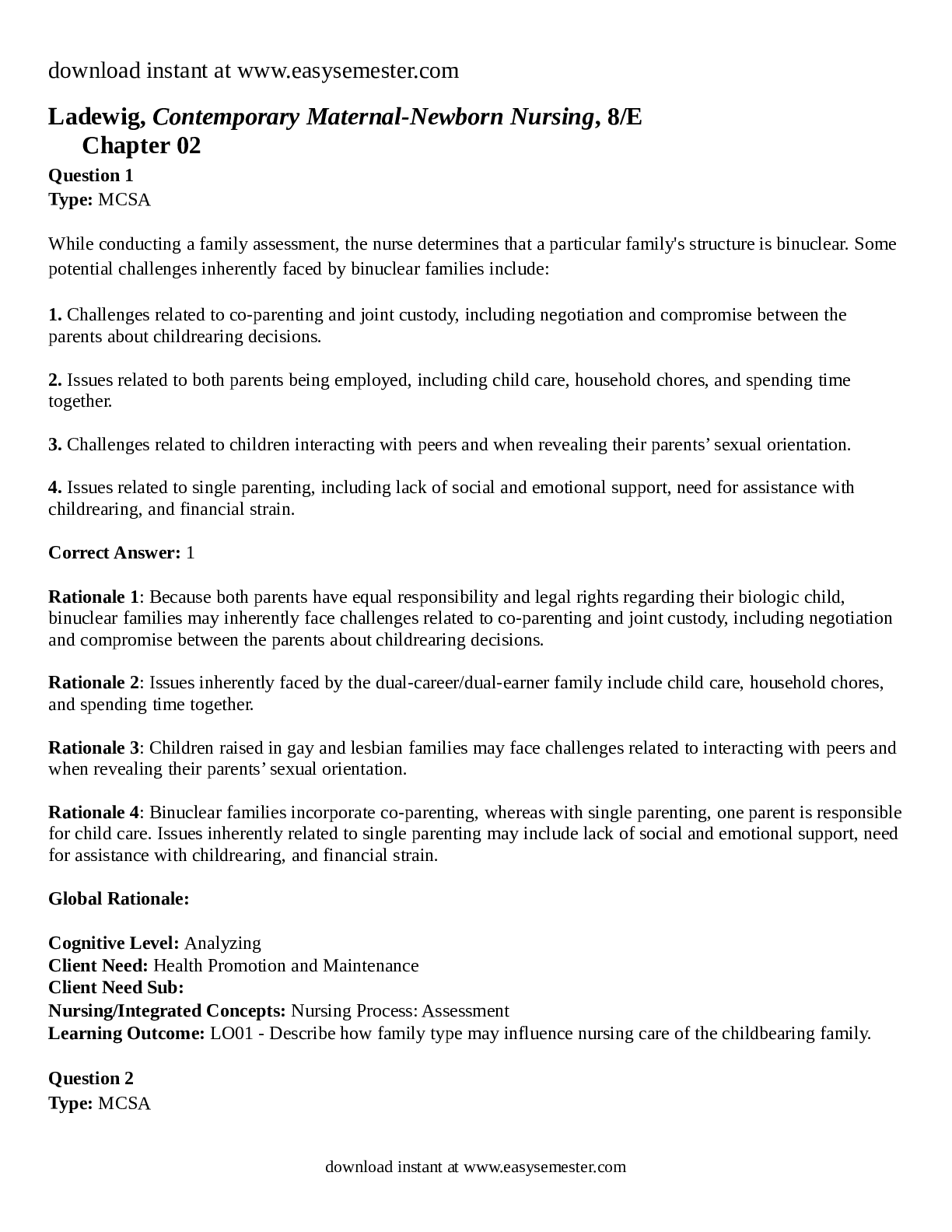
Reviews( 0 )
Document information
Connected school, study & course
About the document
Uploaded On
Jan 28, 2021
Number of pages
13
Written in
Additional information
This document has been written for:
Uploaded
Jan 28, 2021
Downloads
0
Views
45

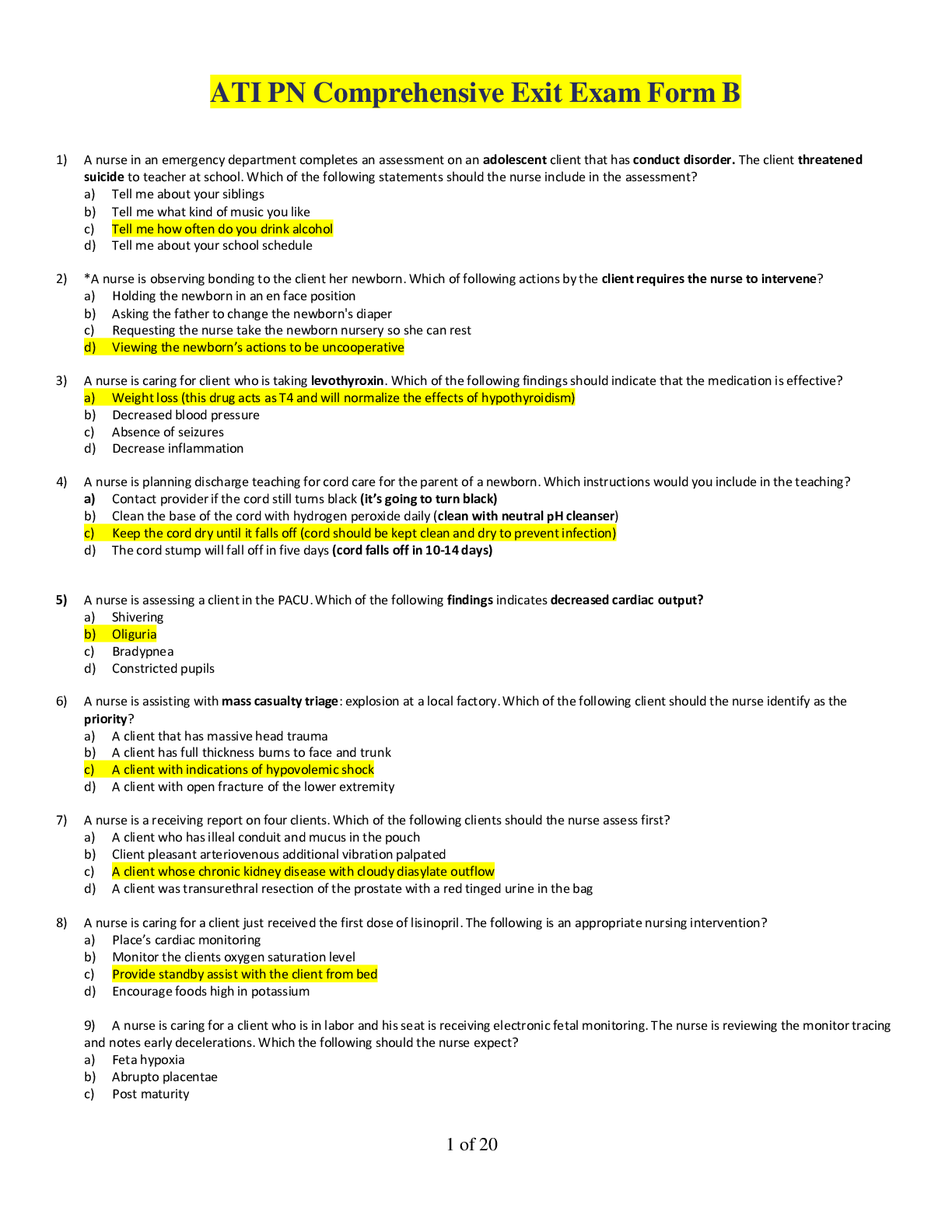
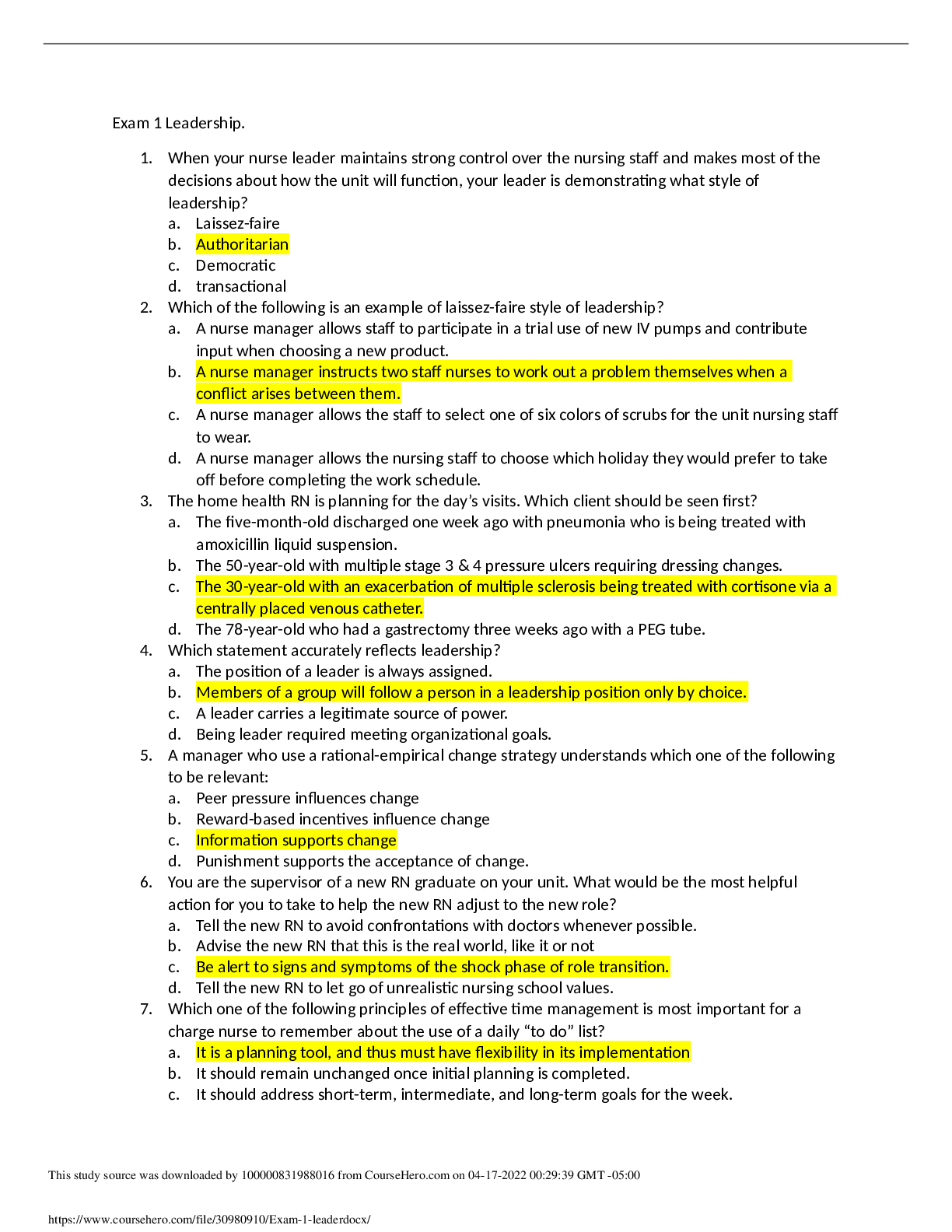
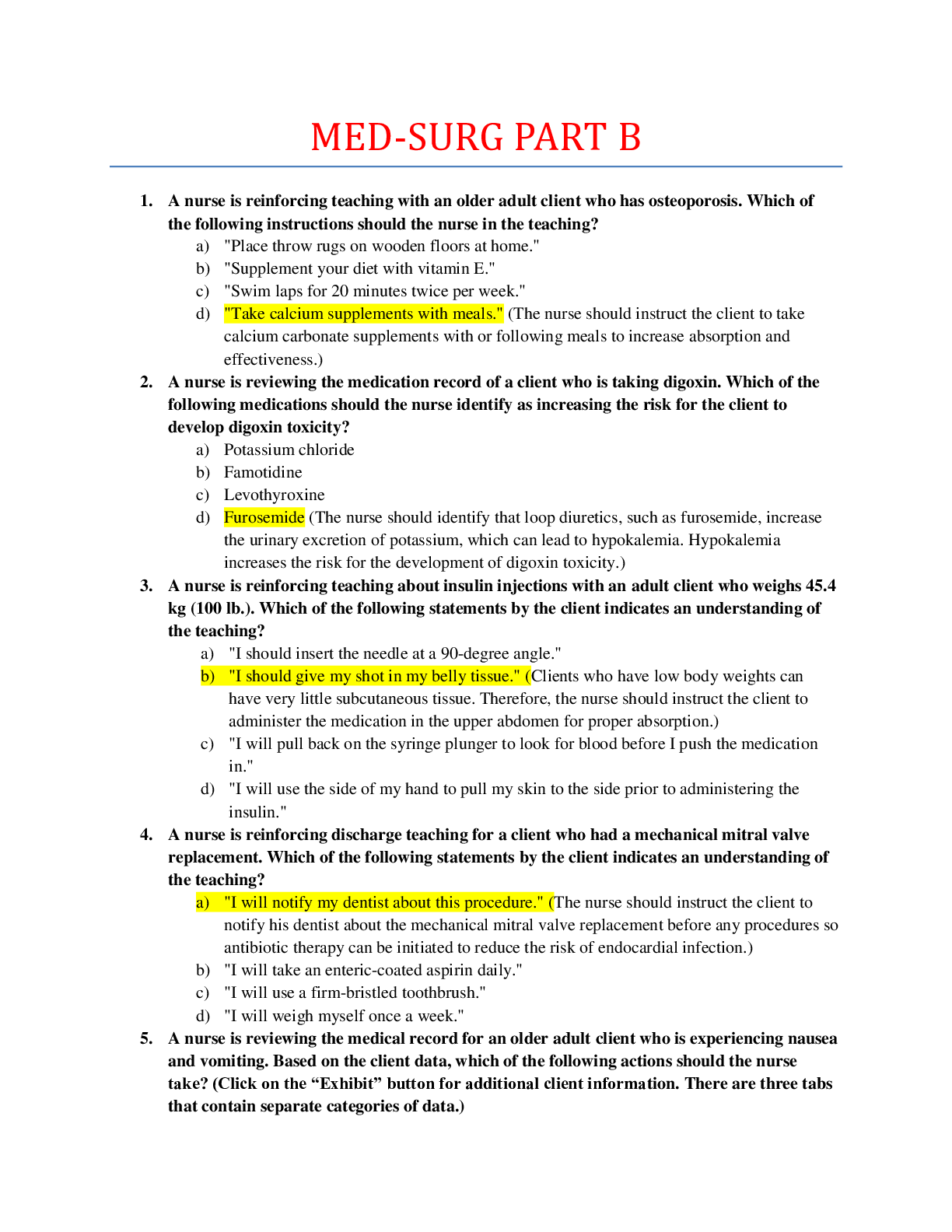
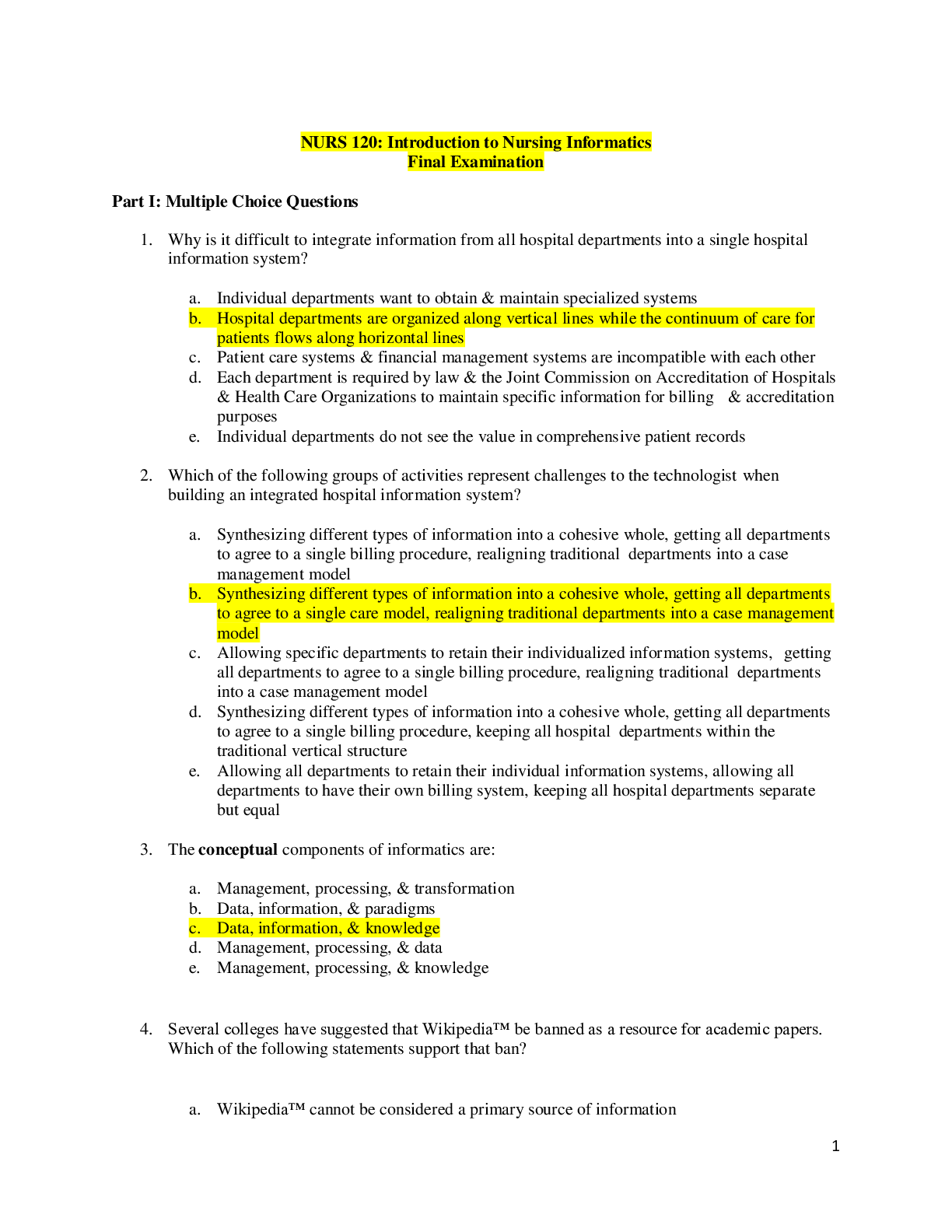
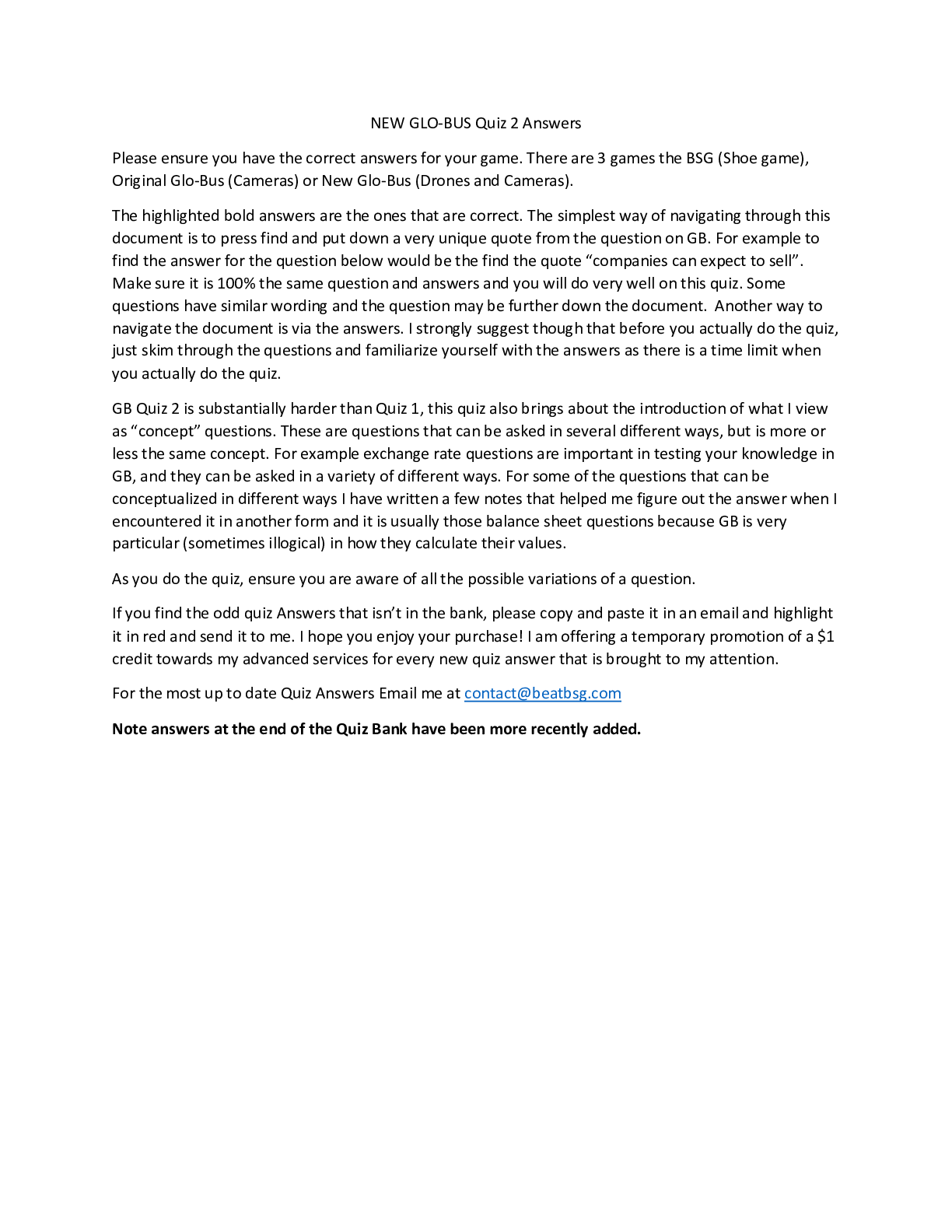
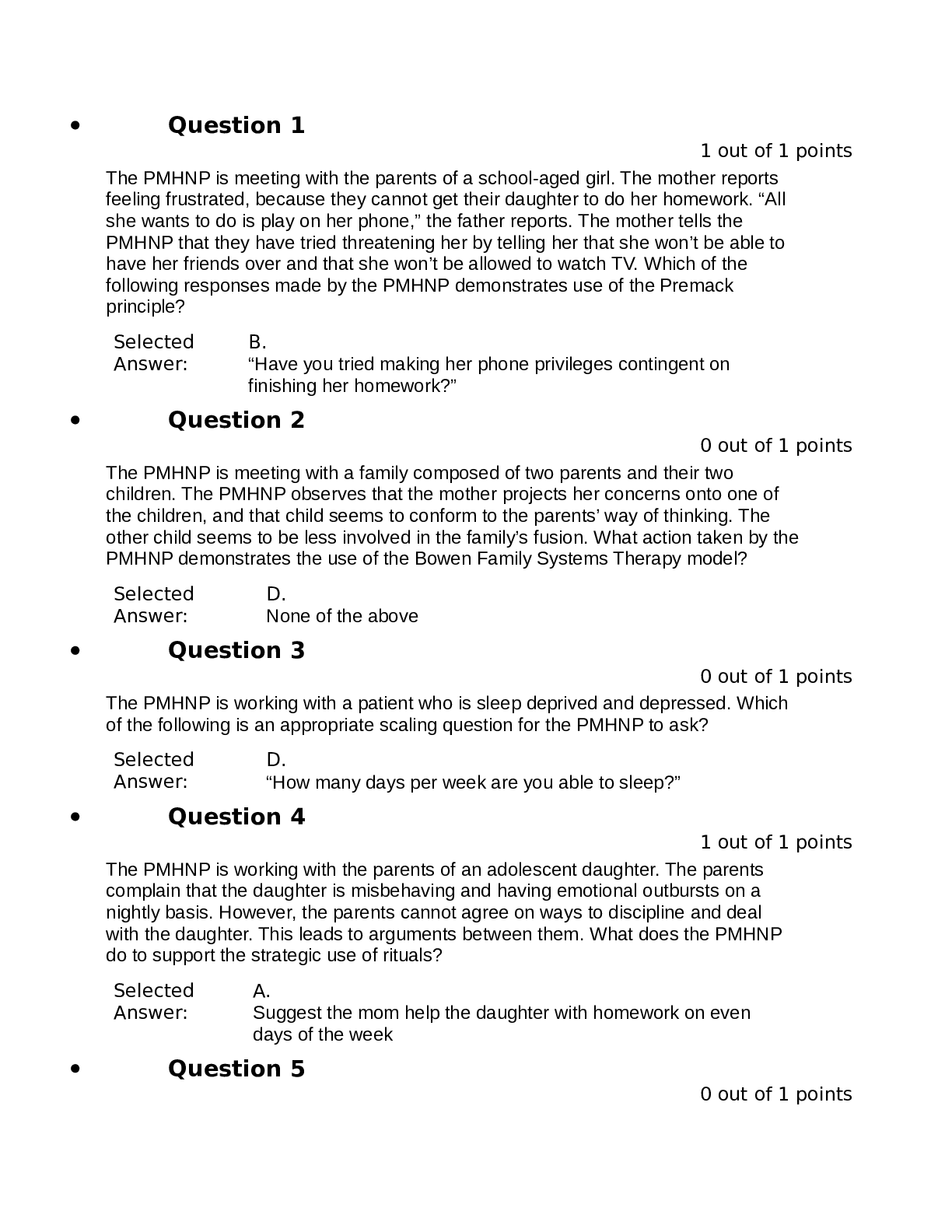
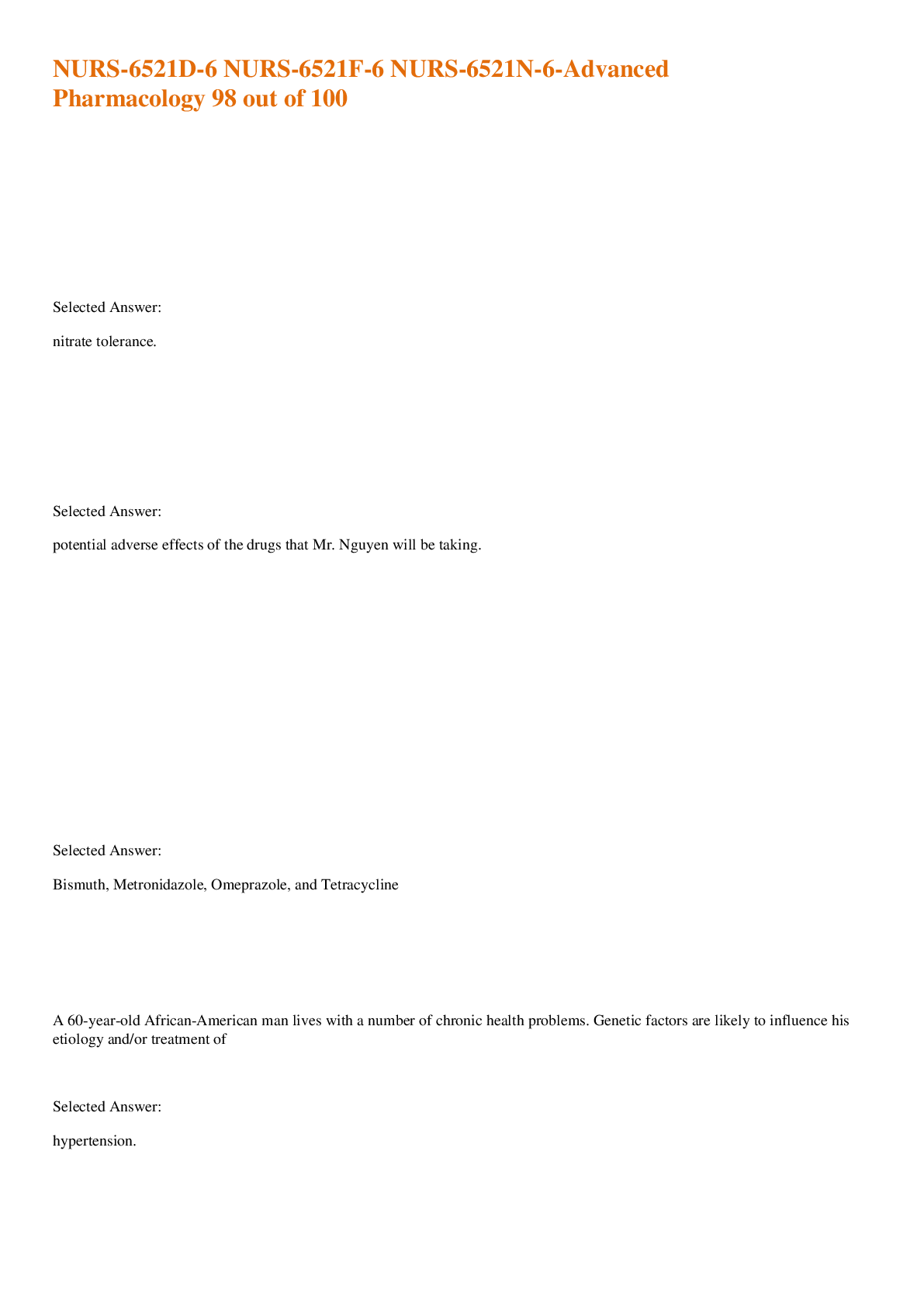
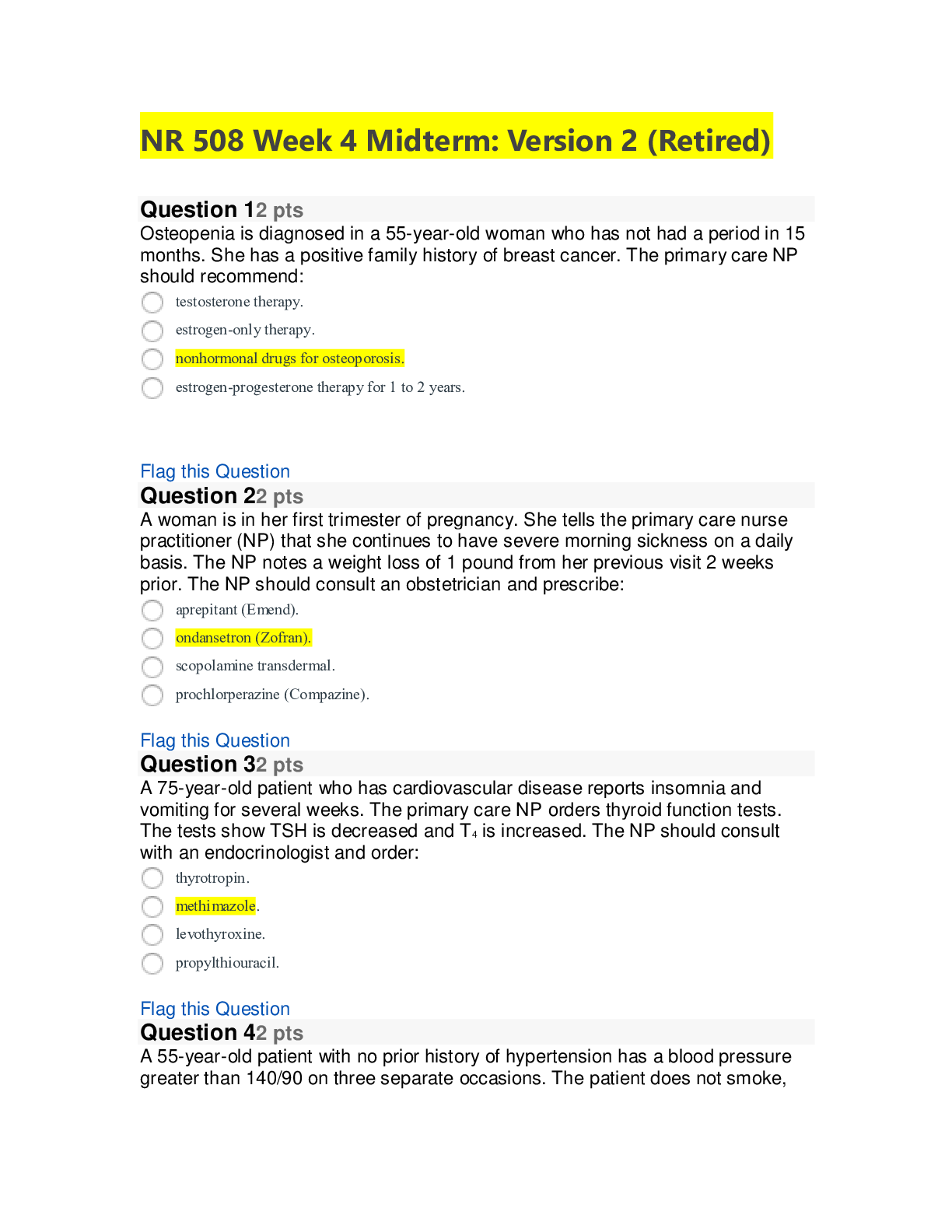
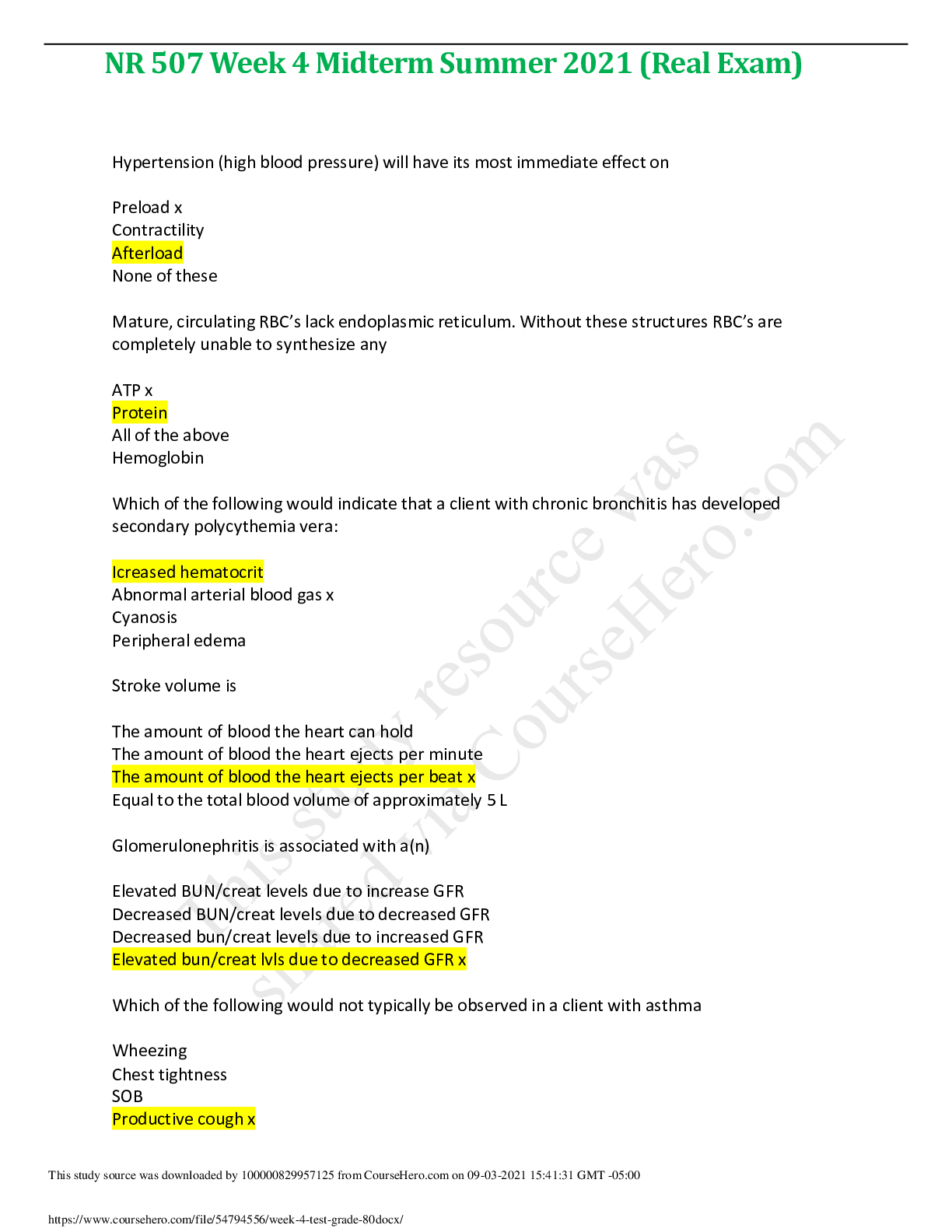
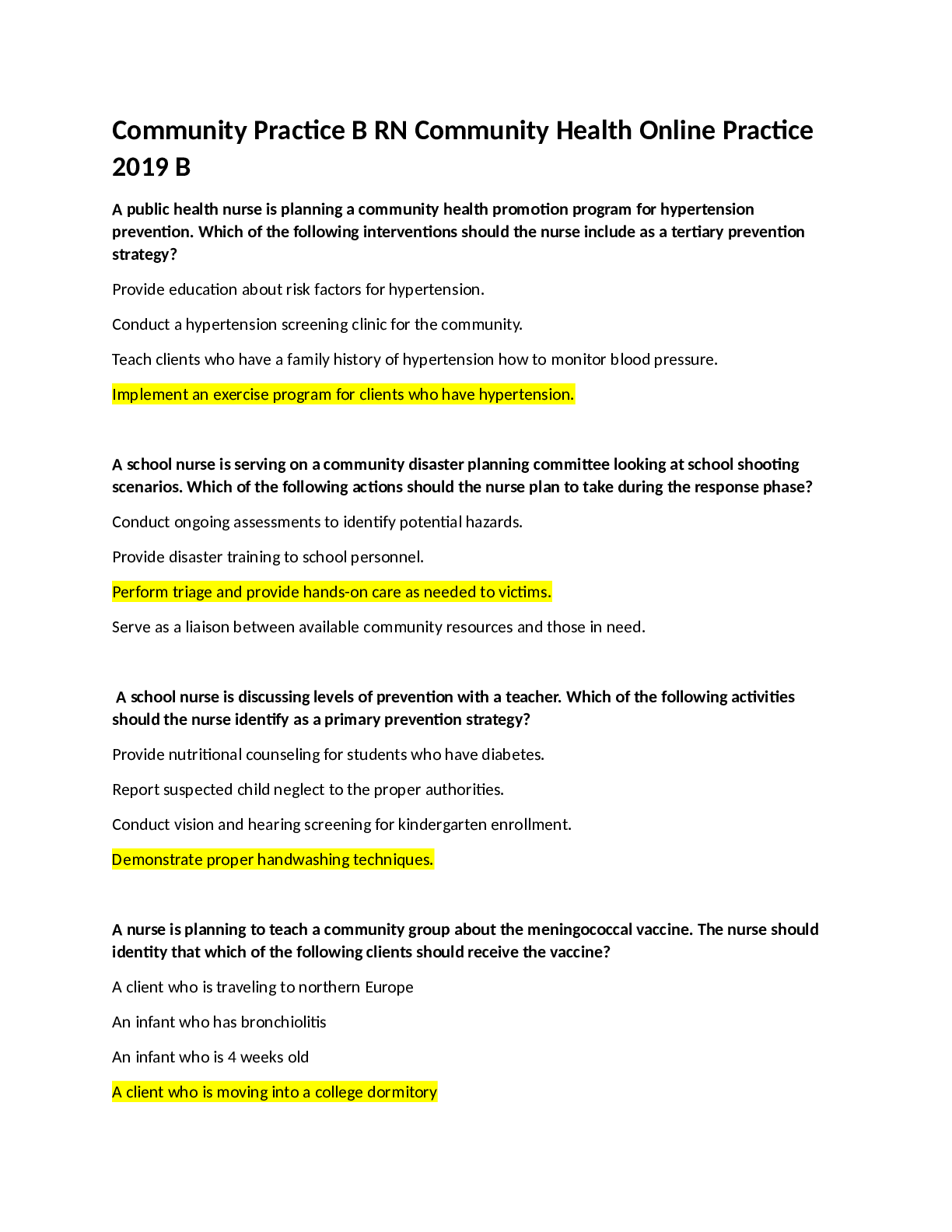
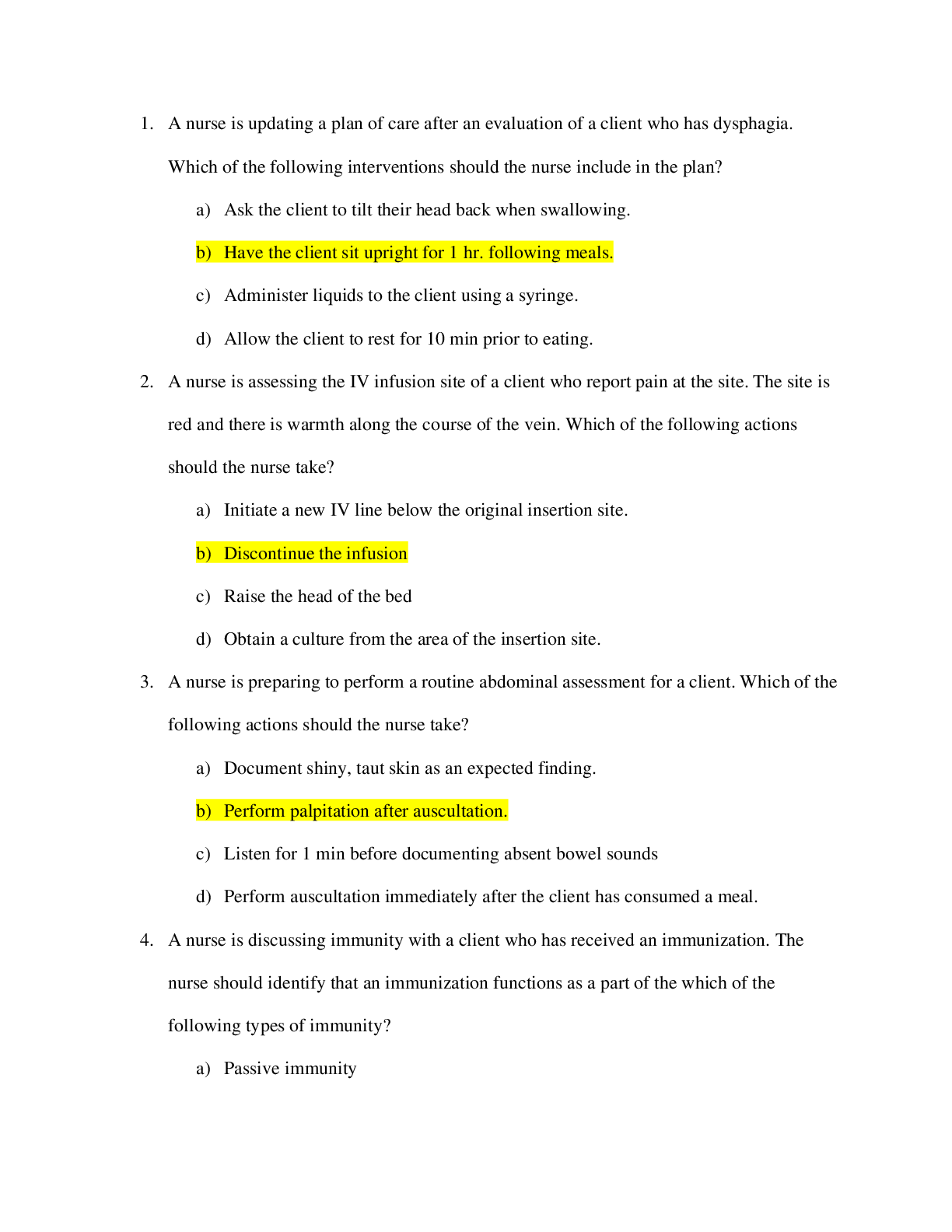
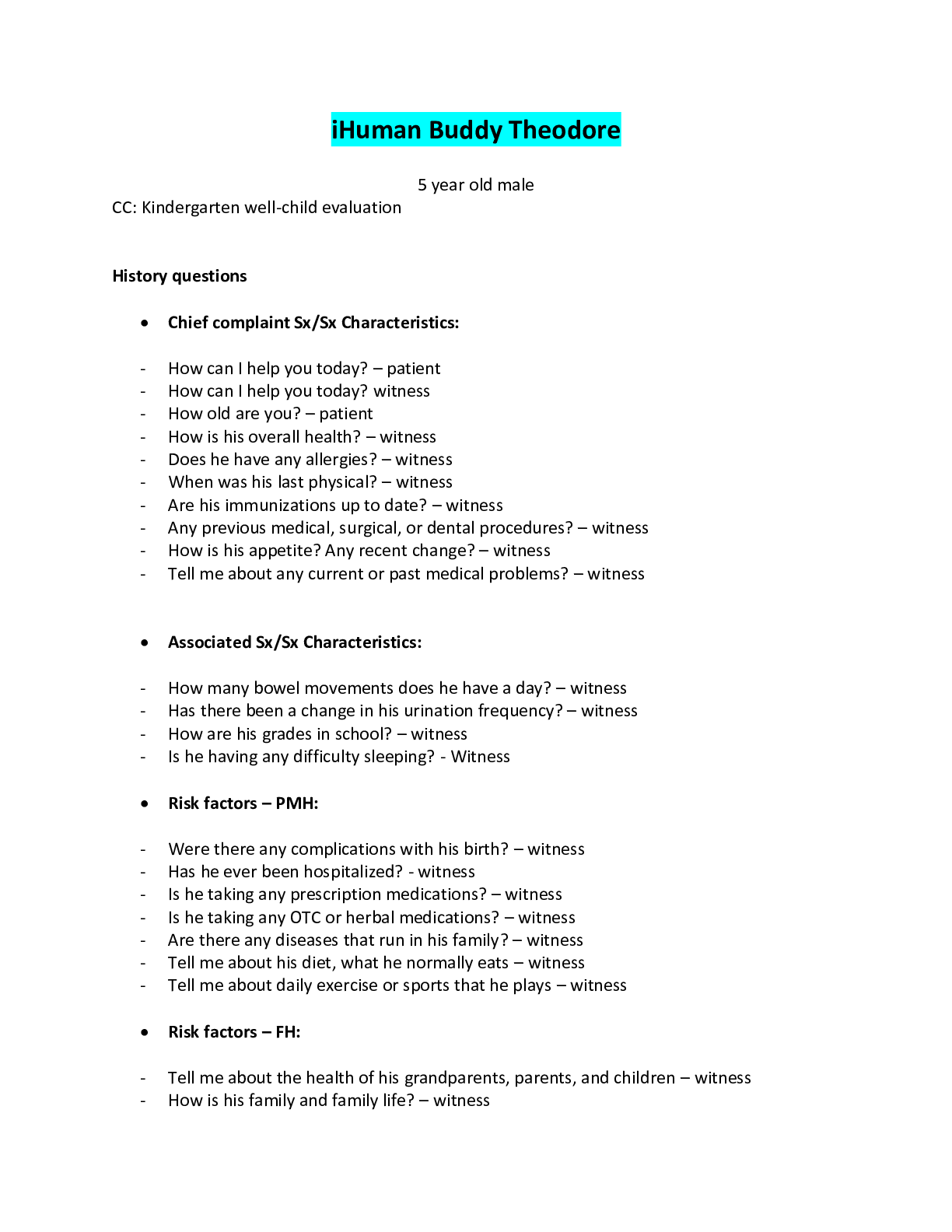
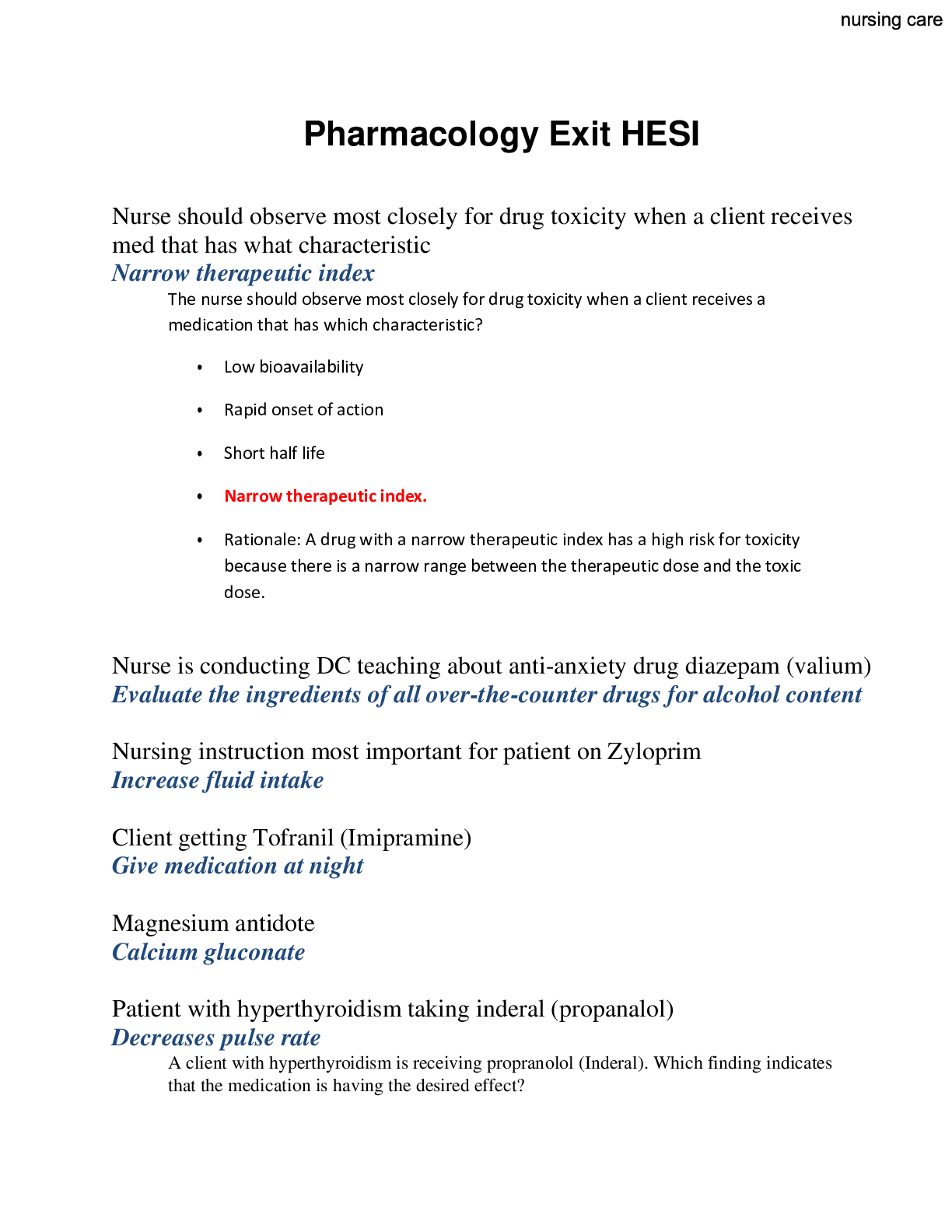
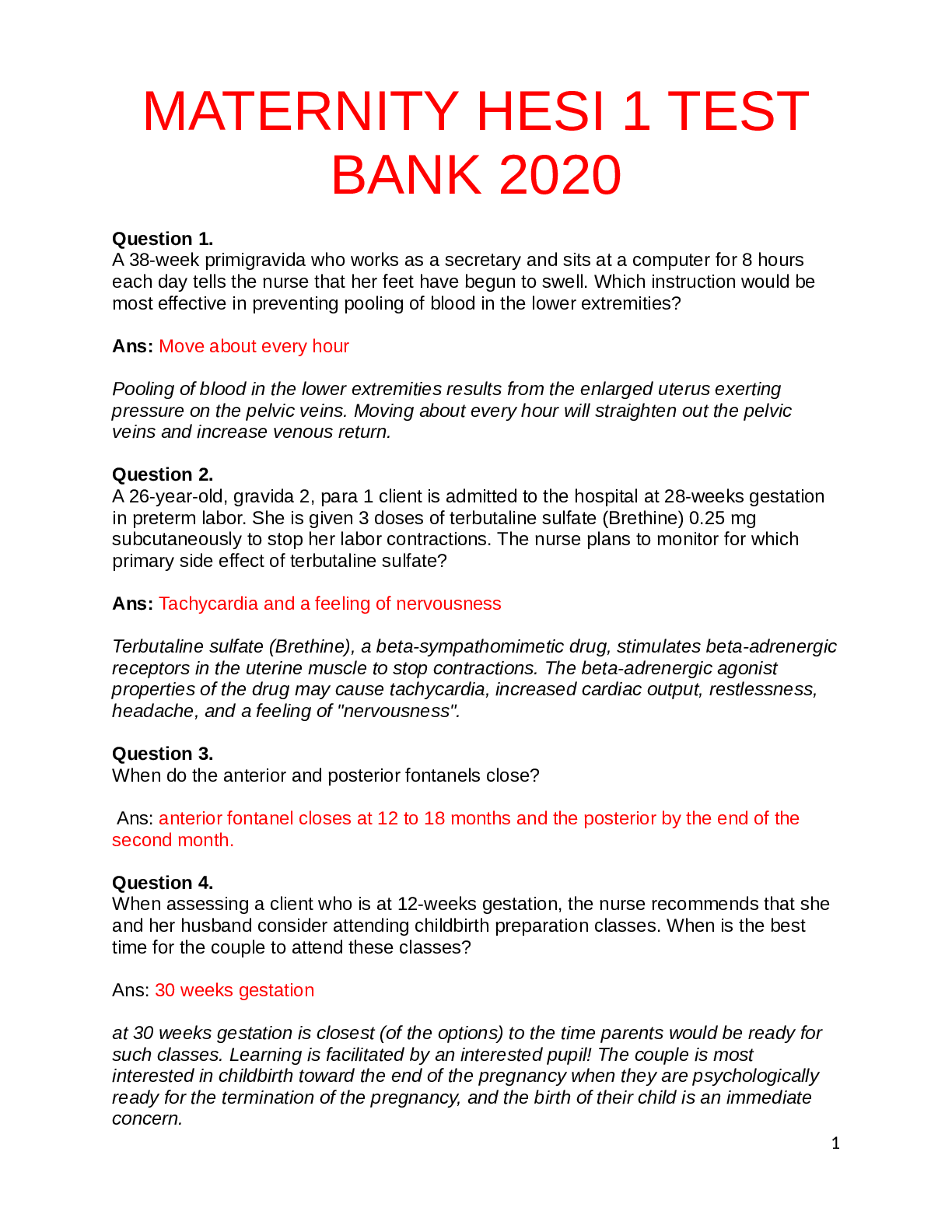
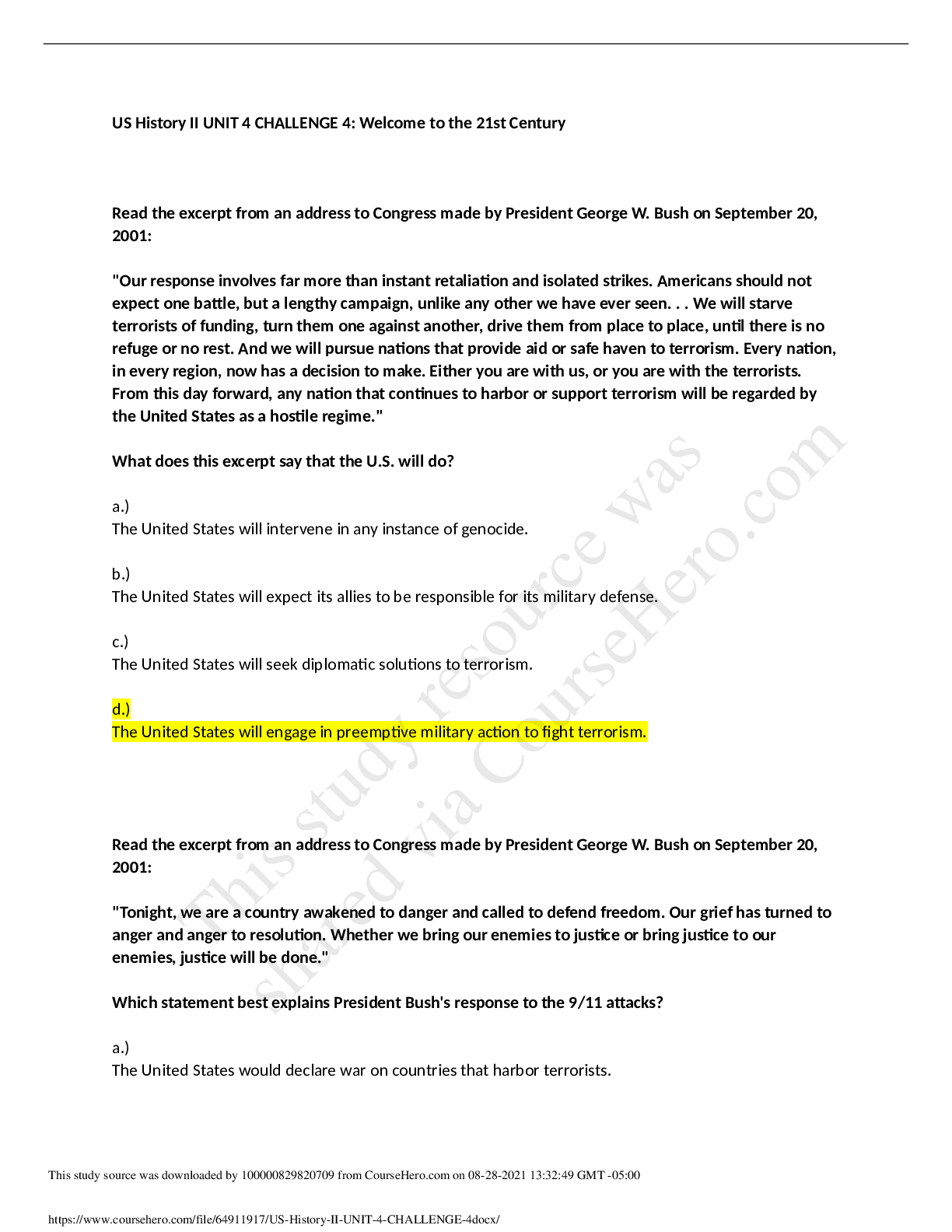
.png)
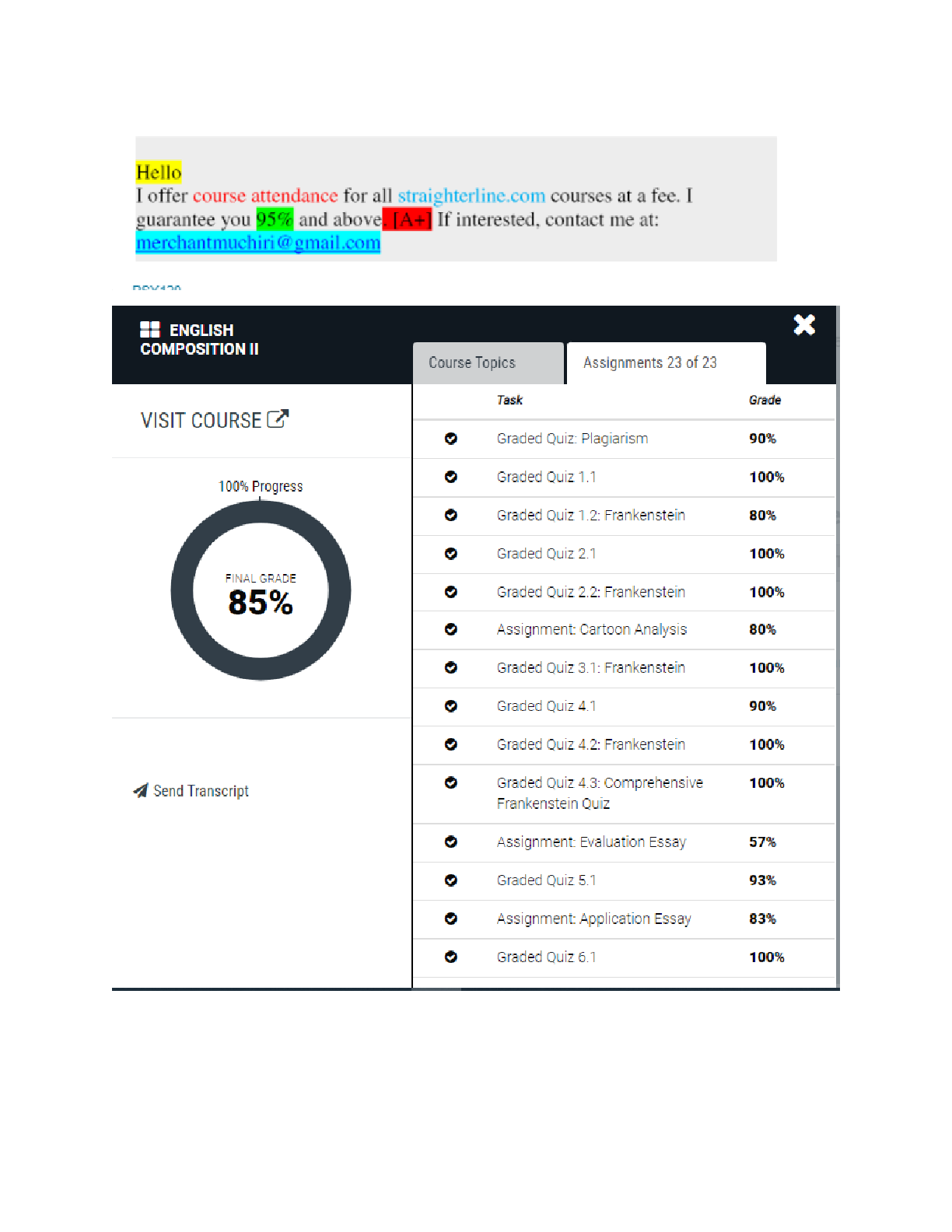
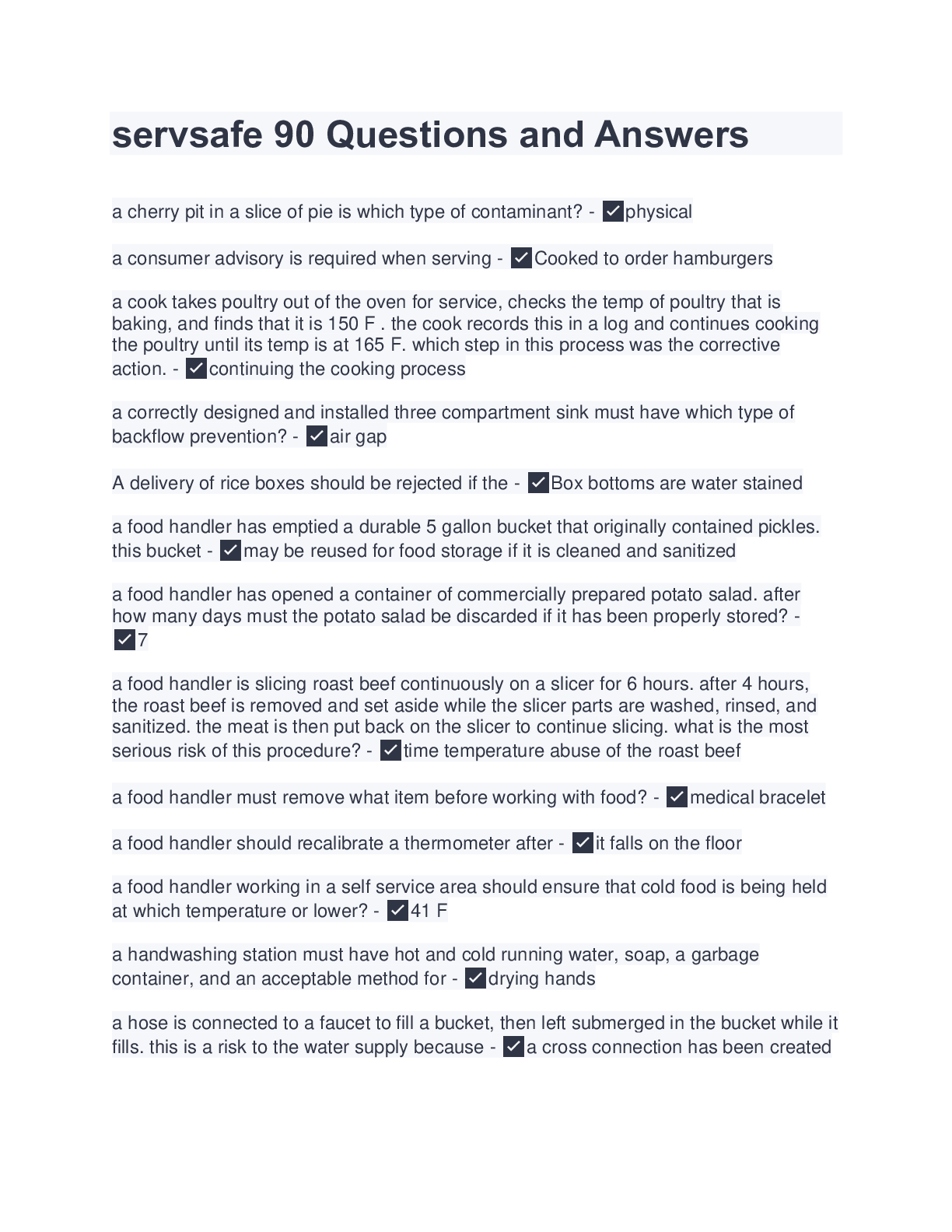
.png)
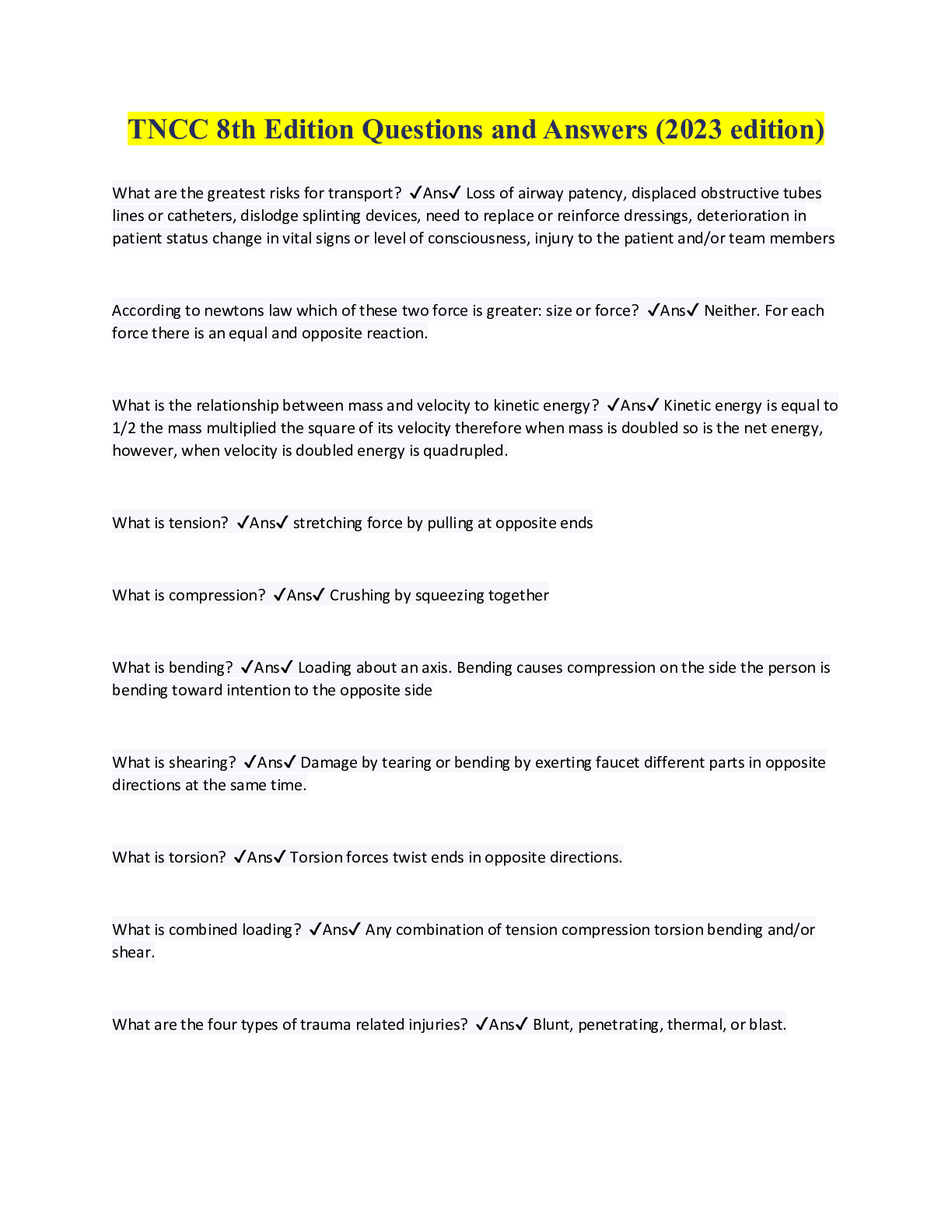
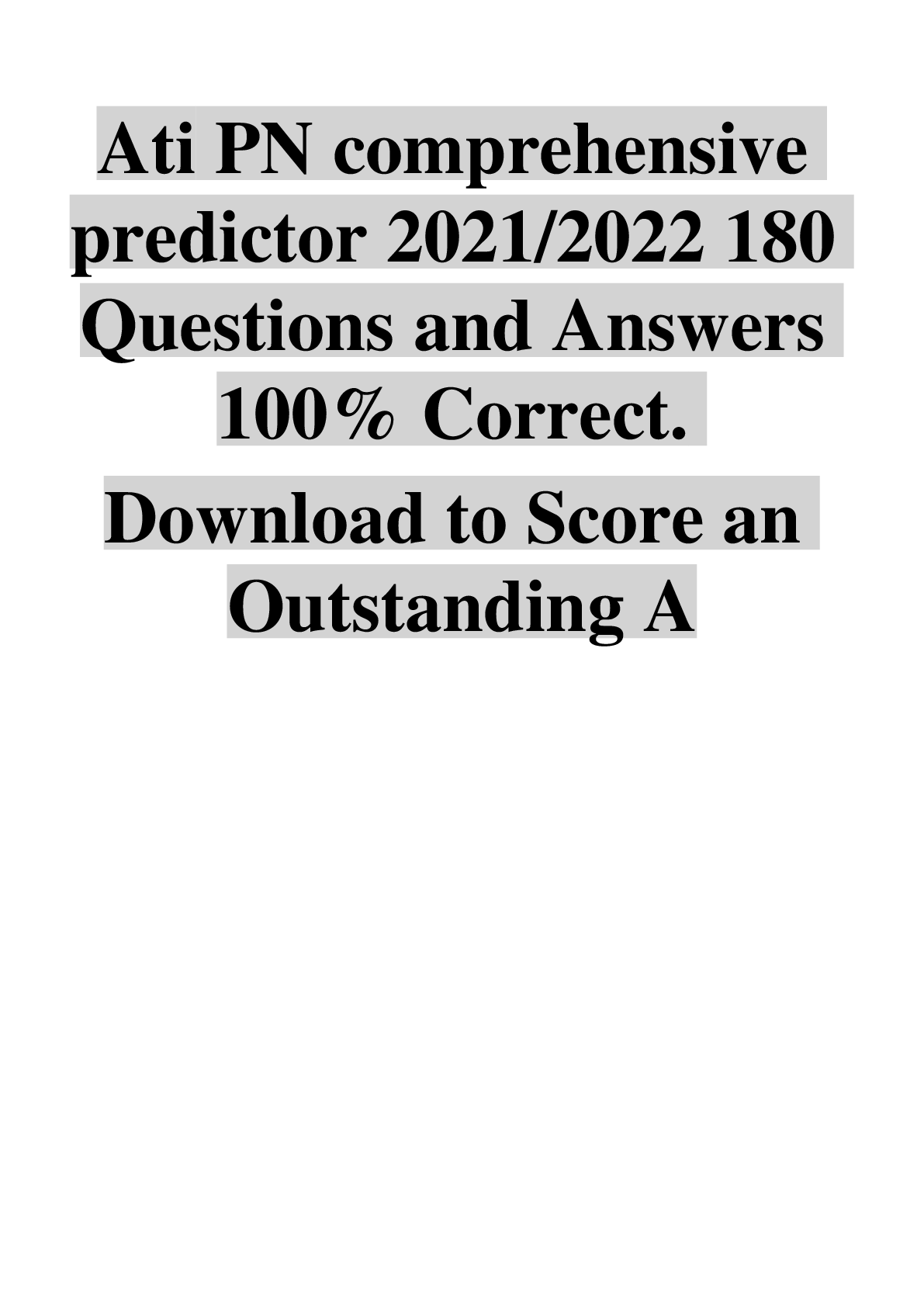

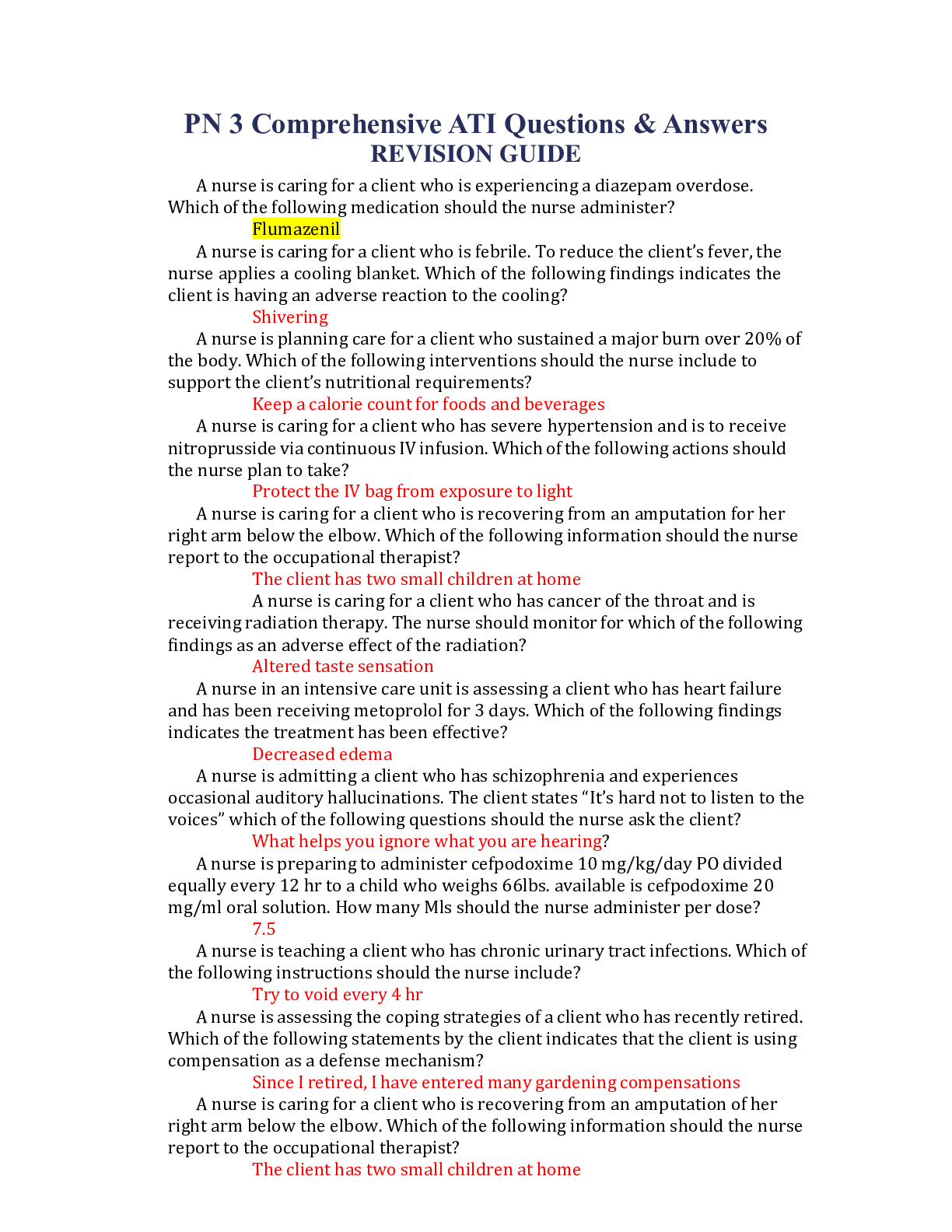
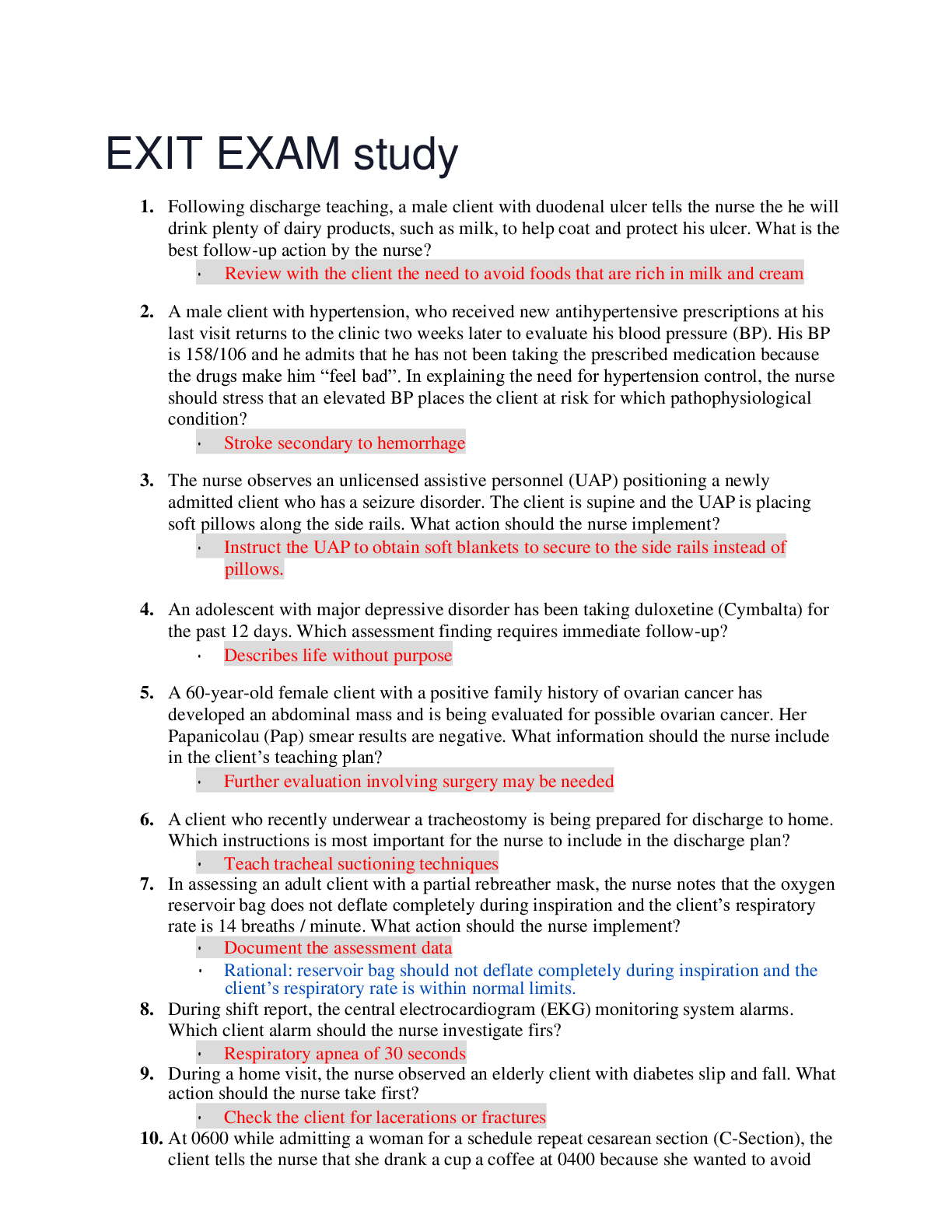
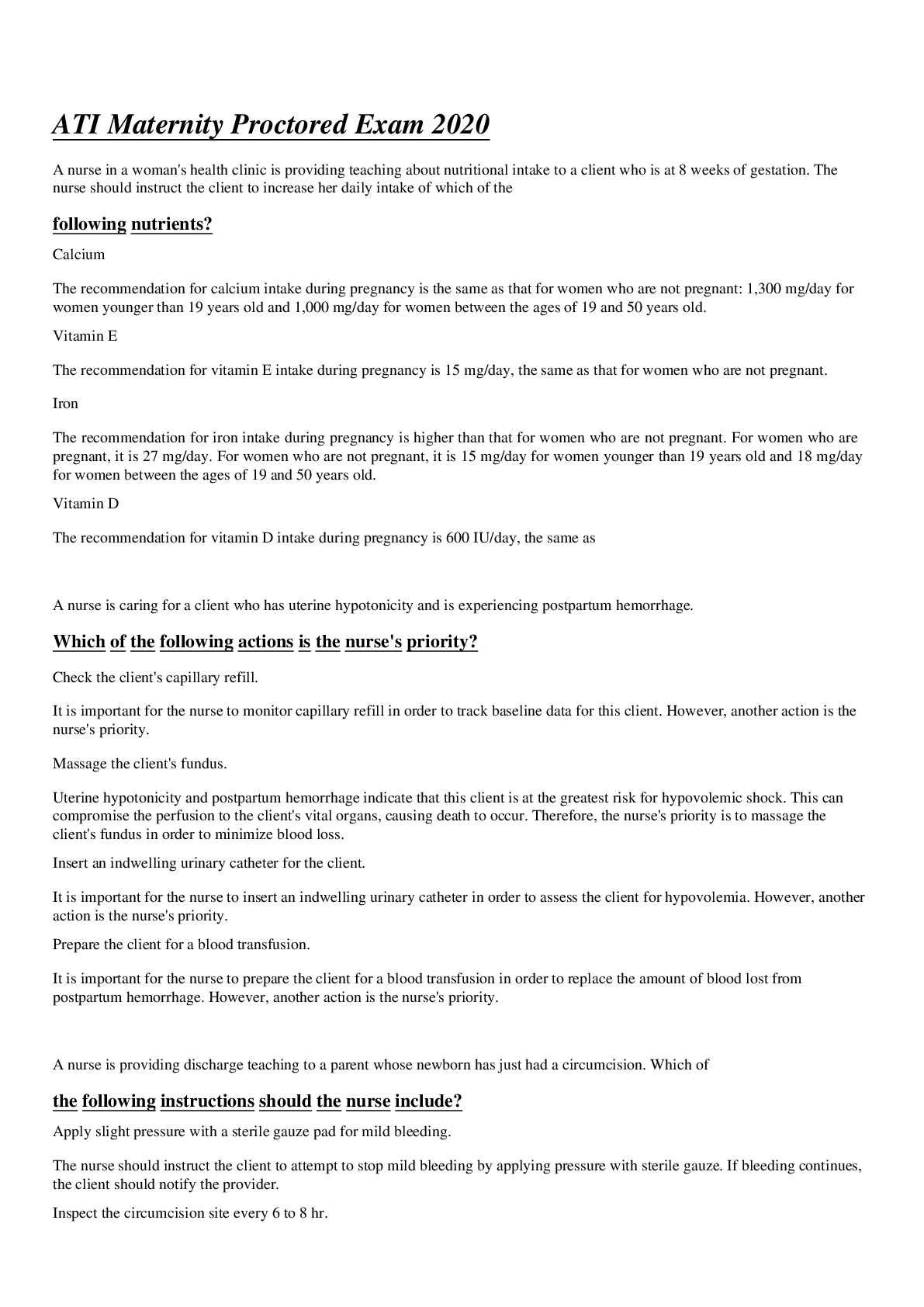
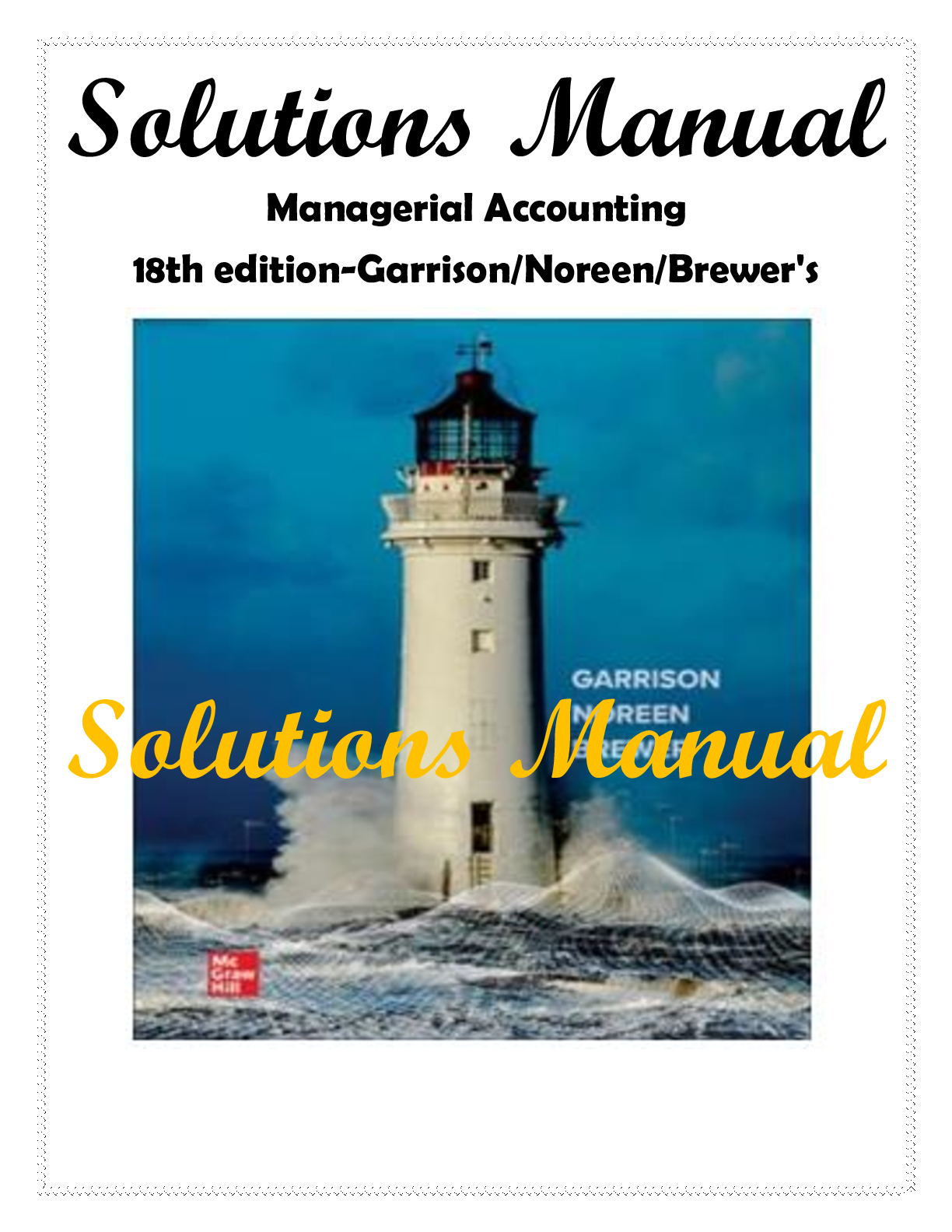
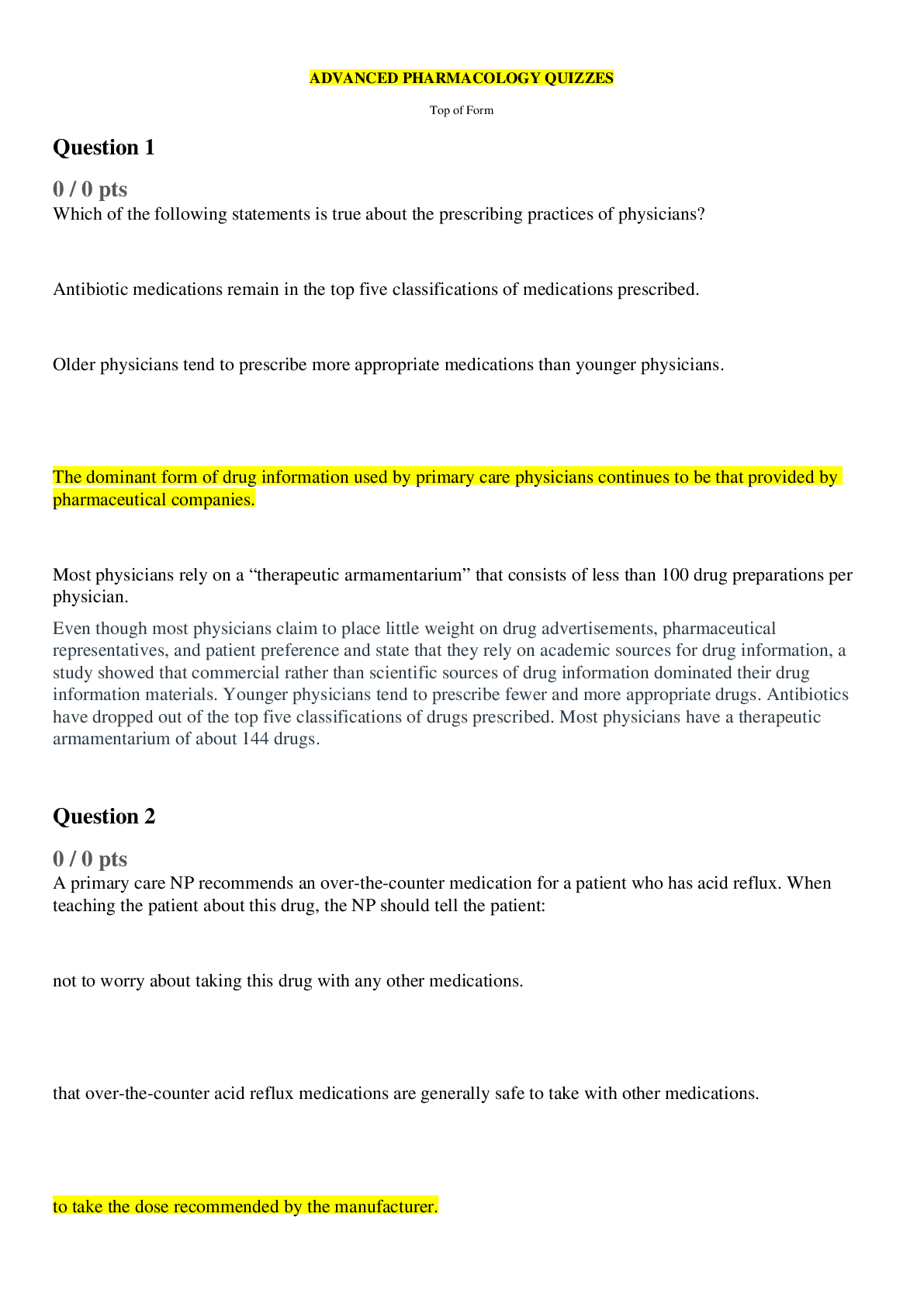
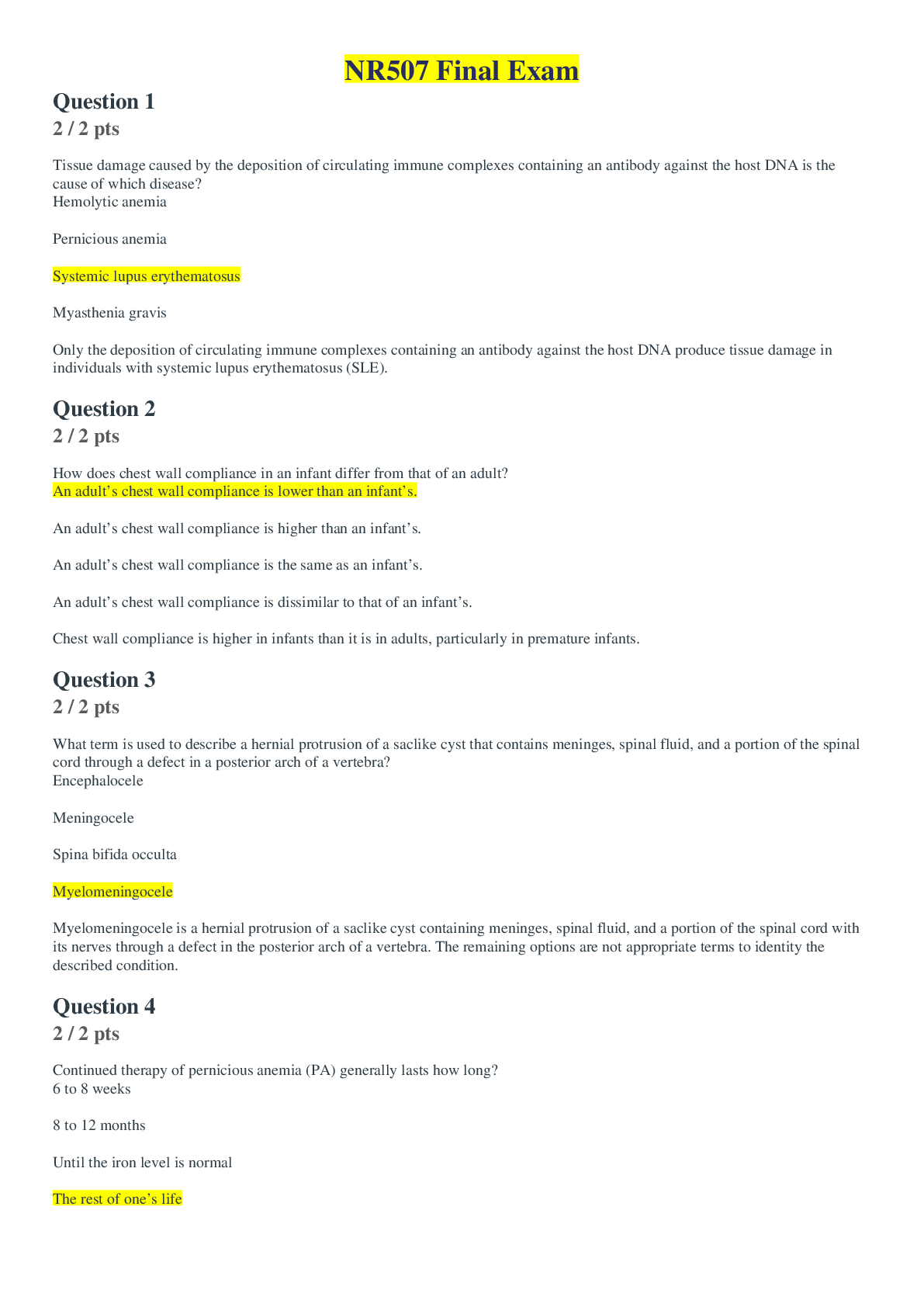
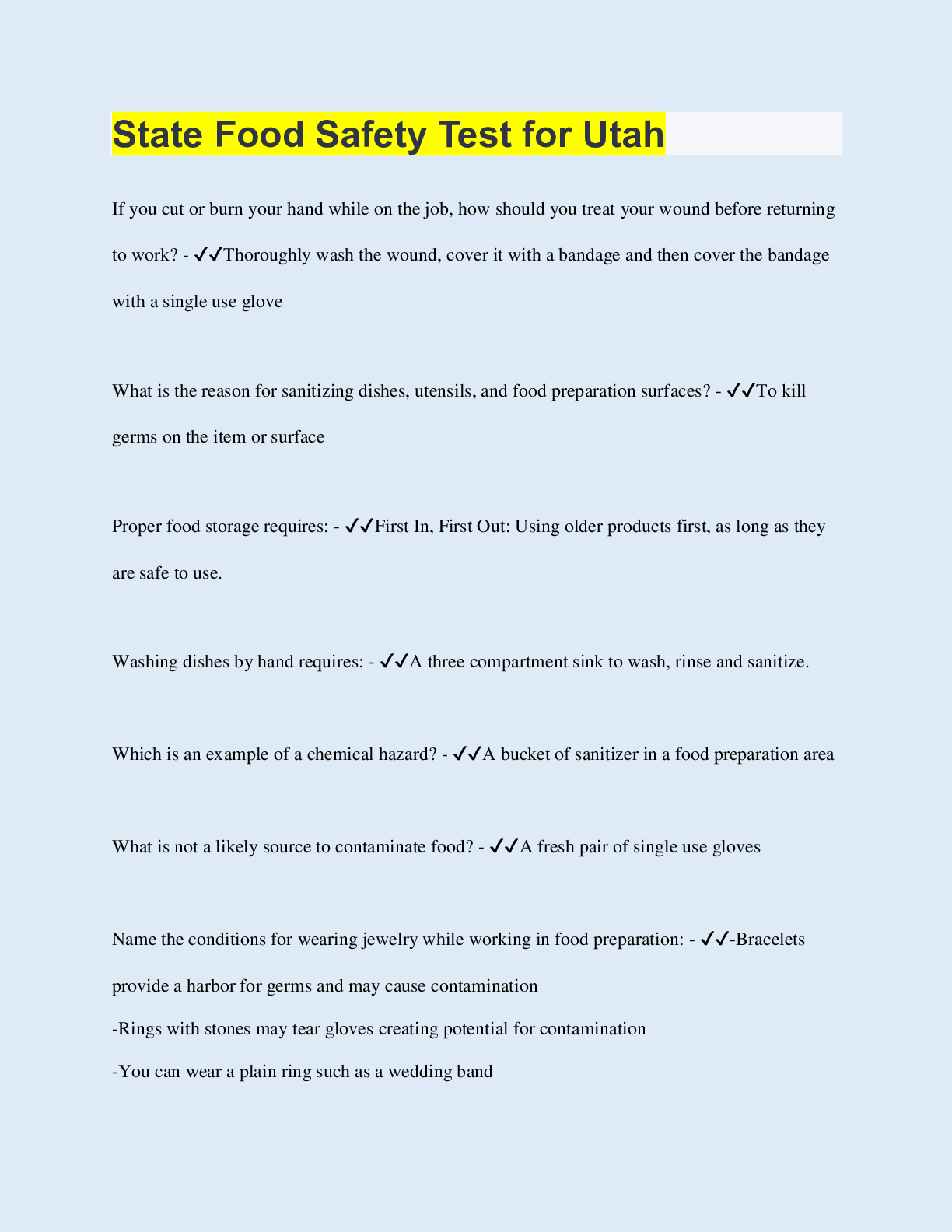

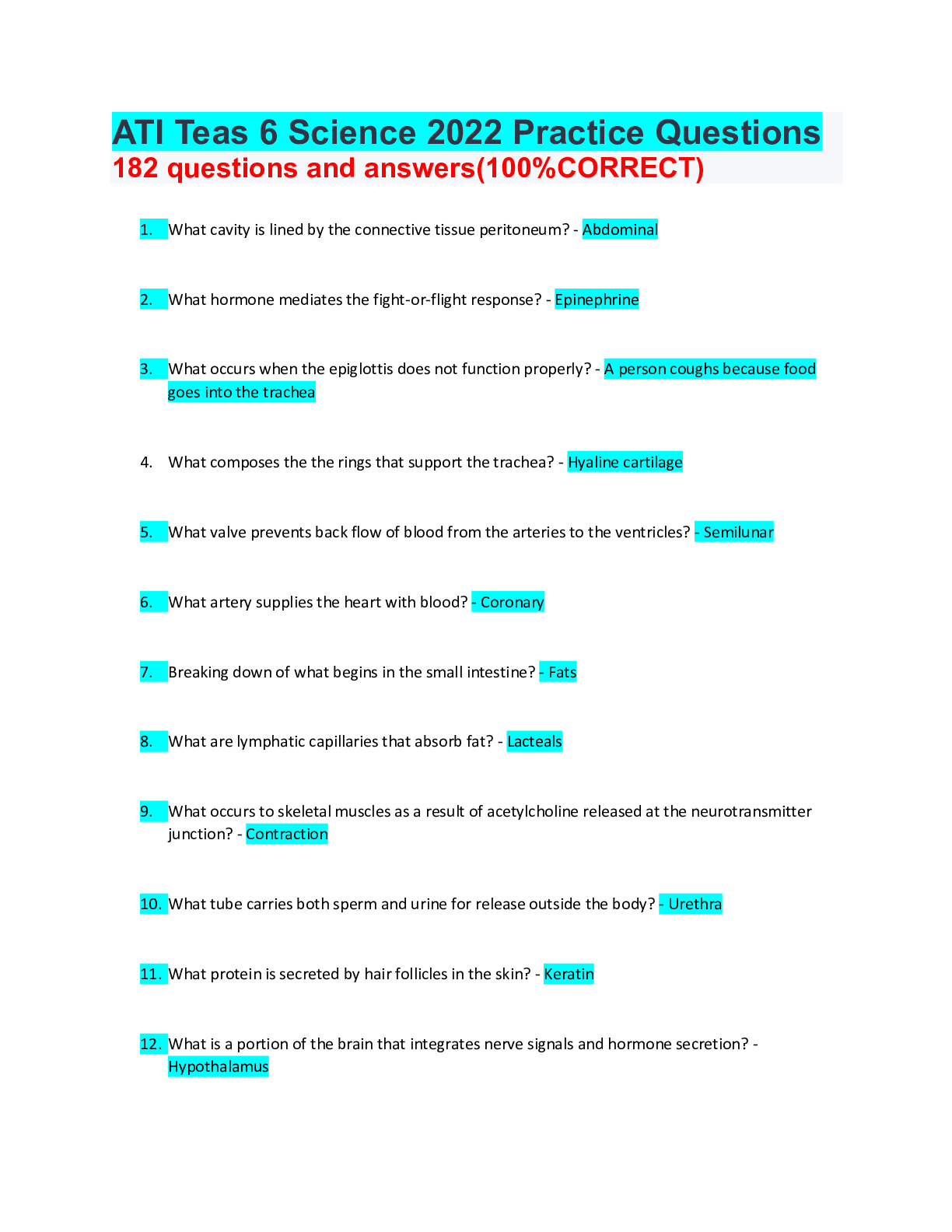
.png)

